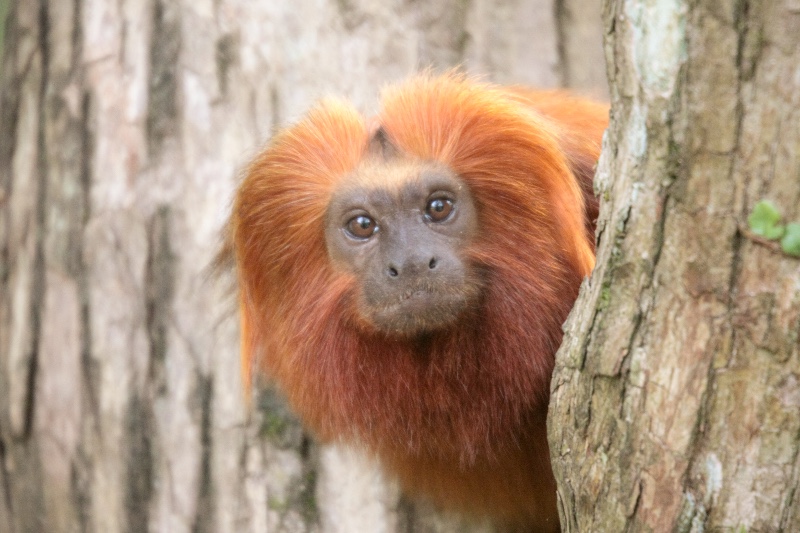
Brazil
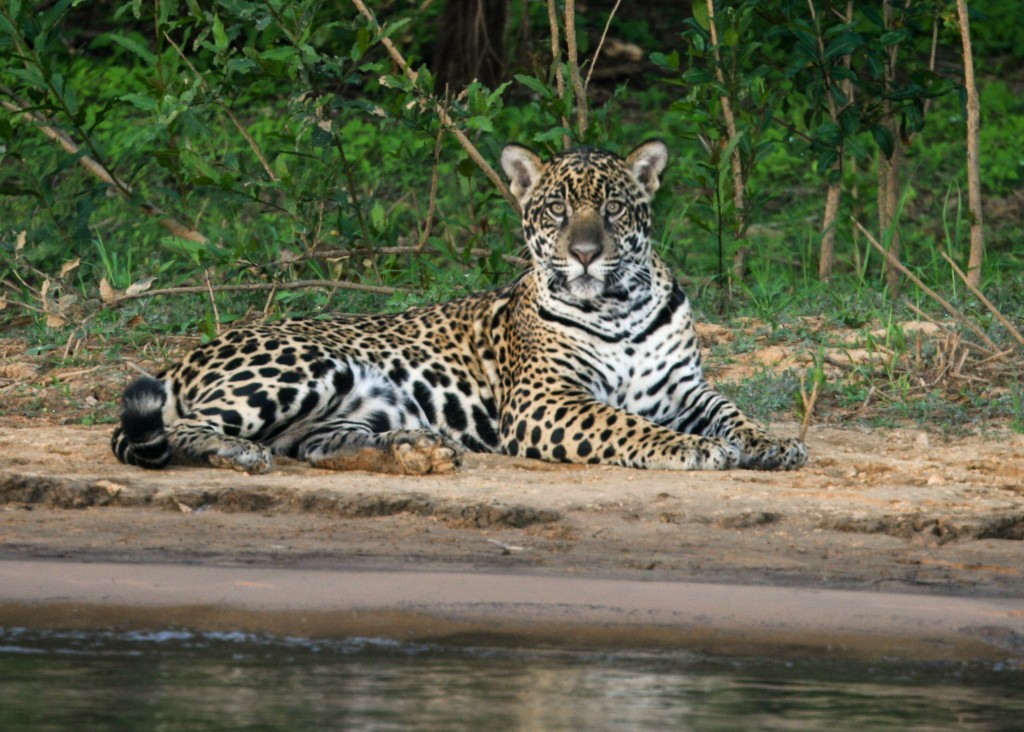
Jaguar, Panthera onca, The Pantanal
I’ve visited Brazil seven times. In October 2006 I spent six days in the western Amazon, at the Palmari Lodge, a four hour boat trip along the Amazon from Leticia, Colombia. See here for the trip report. In August 2007 I returned for two and a half weeks and visited Rio Cristalino (the Central Amazon), the Pantanal and the state of Minas Gerais and onto Espirito Santo. See here for the trip report. In November 2009 I went to Iguazu (for work) and then to the north of Rio de Janeiro to see Golden Lion Tamarins (see Parana and Rio de Janeiro sections lower down this page).
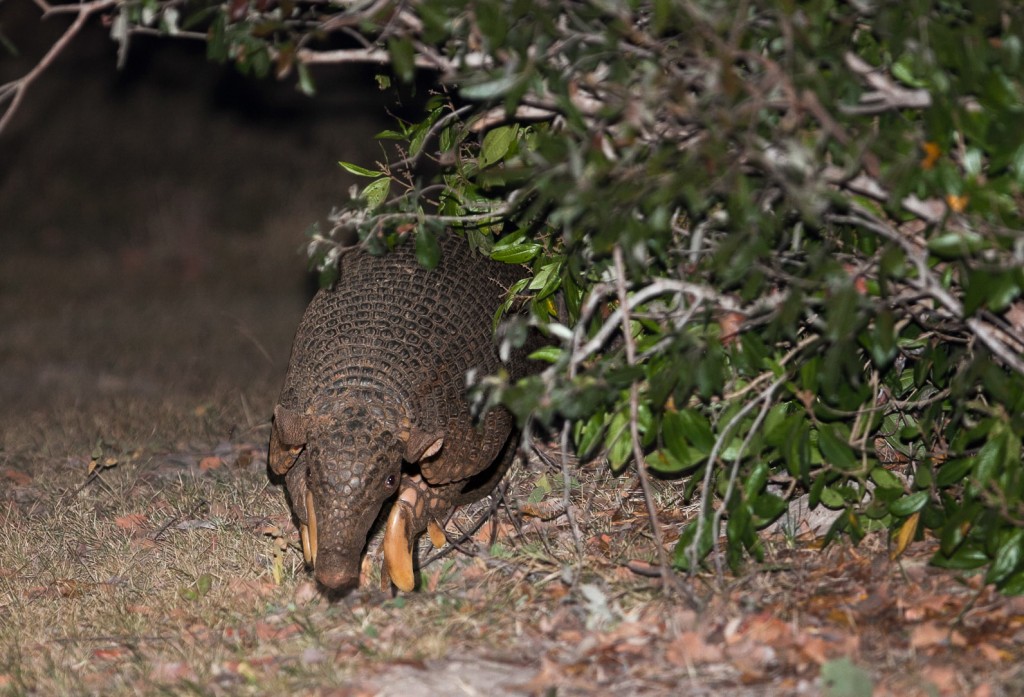
Giant Armadillo, Priodontes maximus, Baia das Pedras.
In August 2013 I spent 2.5 weeks in the Atlantic Rainforest and Southern Pantanal. See here for the trip report. And in June 2017 I took a 2 week cruise through the Amazon basin, perhaps the best trip of my life, followed by three days around Manaus. And in March 2018 I spent a week in search of Black and Black-faced Lion Tamarins. I went back for another 2 week cruise along the Aripuana and Madeira Rivers in October 2019.
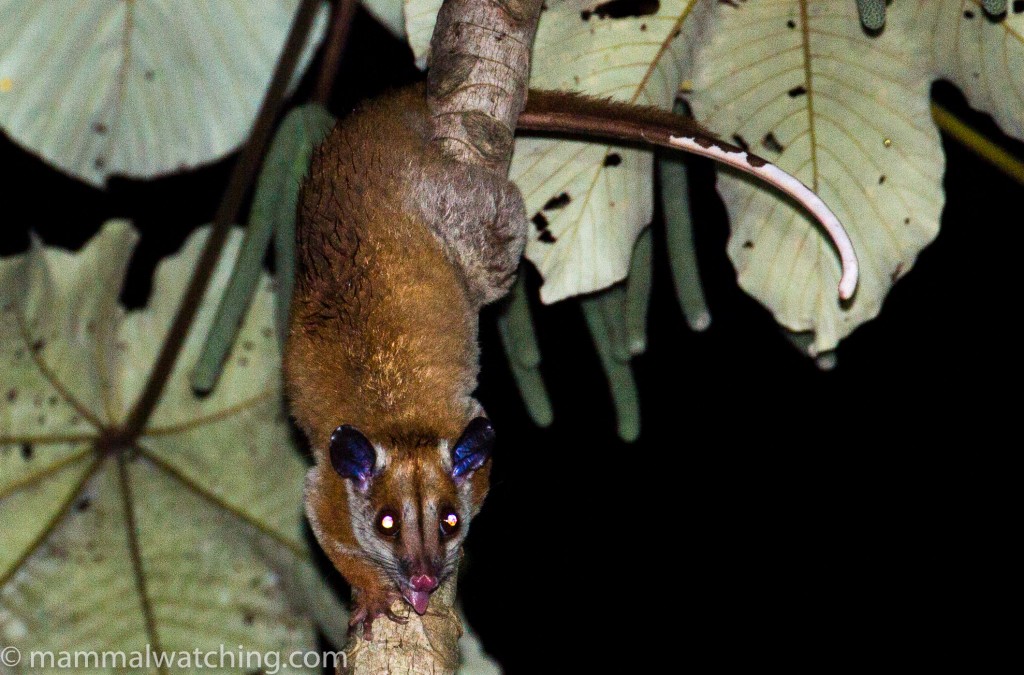
Western Woolly Opossum, Caluromys lanatus, near Manaus.
Amazonas
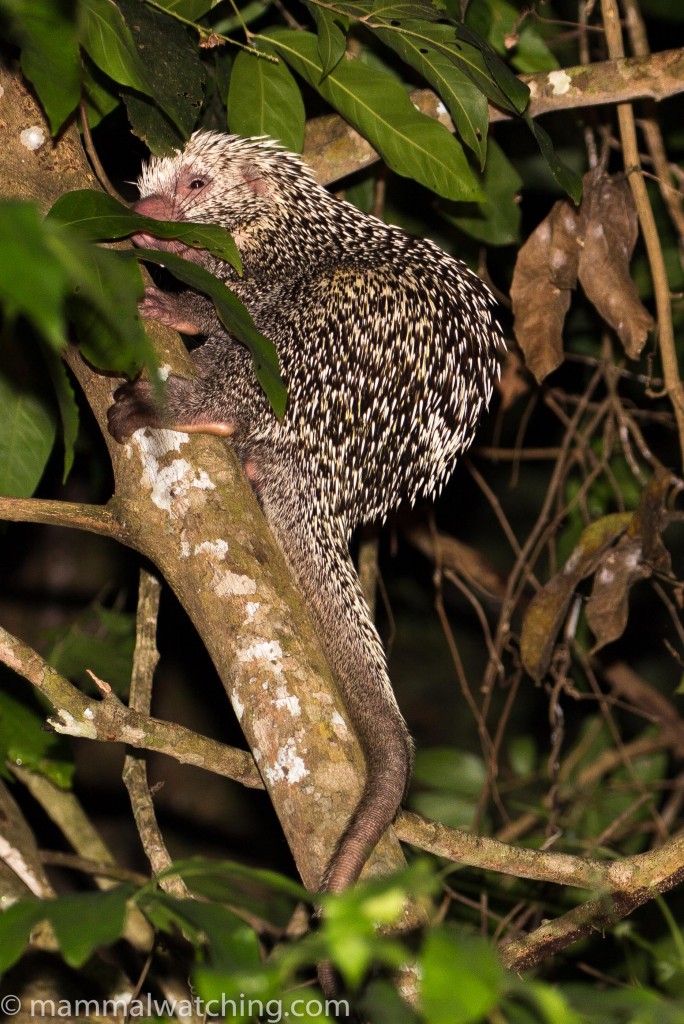
Amazonian Long-tailed Porcupine, Coendou longicaudatus
Amazon Cruises (out of Manaus)
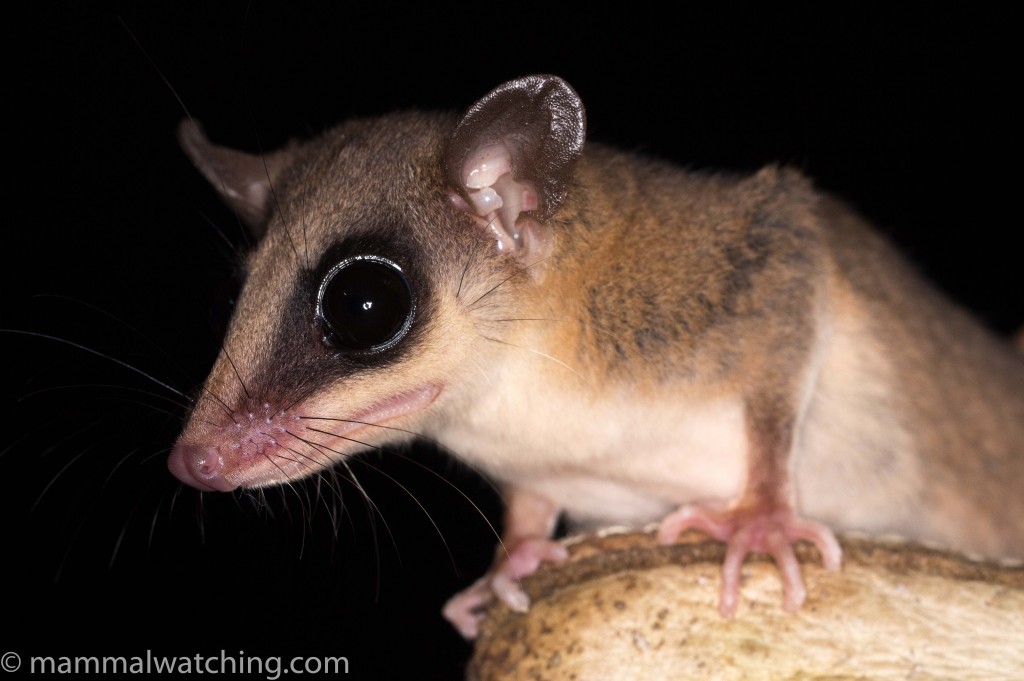
Little Rufous Mouse Opossum, Marmosa lepida
In June 2017 I spent two weeks cruising the Amazon, on a trip I organised with Fiona Reid. This was a mega expedition and we had an exceptional 79 species! Little Rufous Mouse-Opossum, Pebas (Gray) Four-eyed Opossum, Southern Opossum, Western Woolly Opossum, Southern Two-toed Sloth, Pale-throated Three-toed Sloth, Brown-throated Three-toed Sloth, Guianan Squirrel, Yellow-throated Squirrel, Neotropical Pygmy Squirrel, Bicolored Arboreal Rice Rat, White-footed Climbing Mouse, Splendid Climbing Mouse, Black Rat, Amazonian Long-tailed Porcupine, Black-tailed Hairy Dwarf Porcupine, Red-rumped Agouti, Rio Negro Brush-tailed Rat, Spiny rat species (Proechimys cf. brevicauda), Common Spiny Tree Rat, Amazon Bamboo Rat,
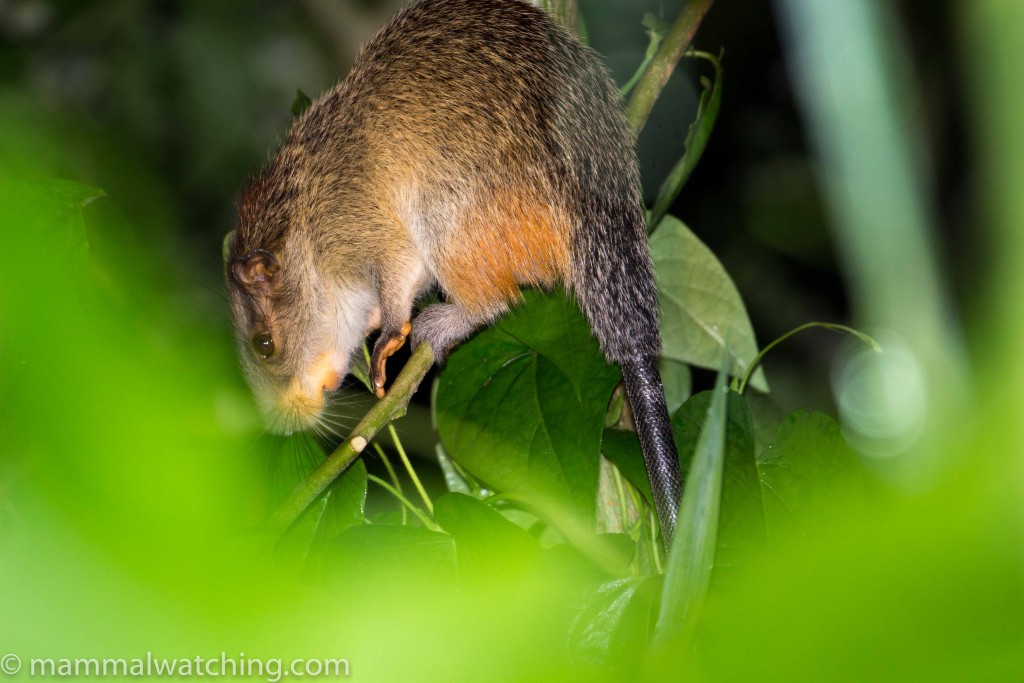
Amazon Bamboo Rat, Dactylomys dactylinus
Giant Tree Rat, Red-nosed Tree Rat, Giant Tree Rat, Red-nosed Tree Rat, Kinkajou, Proboscis Bat, Frosted White-lined Bat, Amazonian White-lined Bat, Lesser White-lined Bat, Pallid-winged Dog-like Bat, Greater Dog-like Bat, Northern Ghost Bat, Lesser Fishing Bat, Greater Fishing Bat, Niceforo’s Bat, White-throated Round-eared Bat,
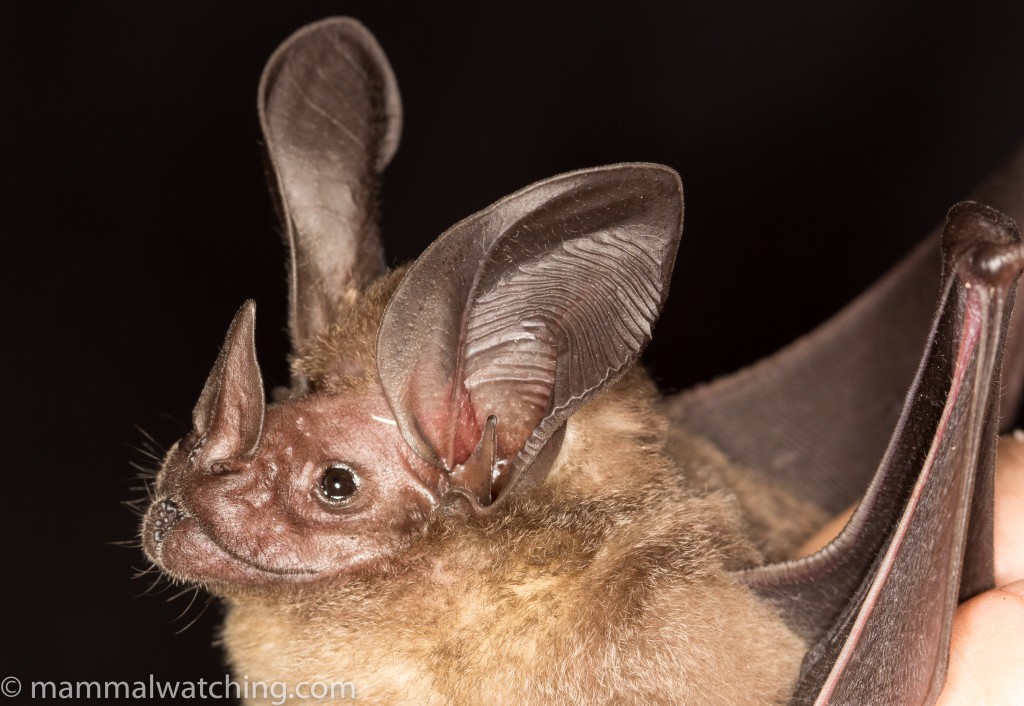
White-Throated Round-eared Bat, Lophostoma silvicola
Striped Hairy-nosed Bat, Lesser Spear-nosed Bat, Guianan Spear-nosed Bat, Pale-faced Bat, Common Long-tongued Bat, Tailed Tailless Bat, Silky Short-tailed Bat, Ben Keith’s Short-tailed Bat, Seba’s Short-tailed Bat, Fischer’s Little Fruit Bat, Dwarf Little Fruit Bat, Little Yellow-shouldered Bat, Common Tent-making Bat, Brown Tent-making Bat, Inca Broad-nosed Bat, Brock’s Yellow-eared Bat, Northern Little Yellow-eared Bat, Gervais’s Fruit-eating Bat, Great Fruit-eating Bat, Dark Fruit-eating Bat, Flat-faced Fruit-eating Bat, Common Vampire Bat,
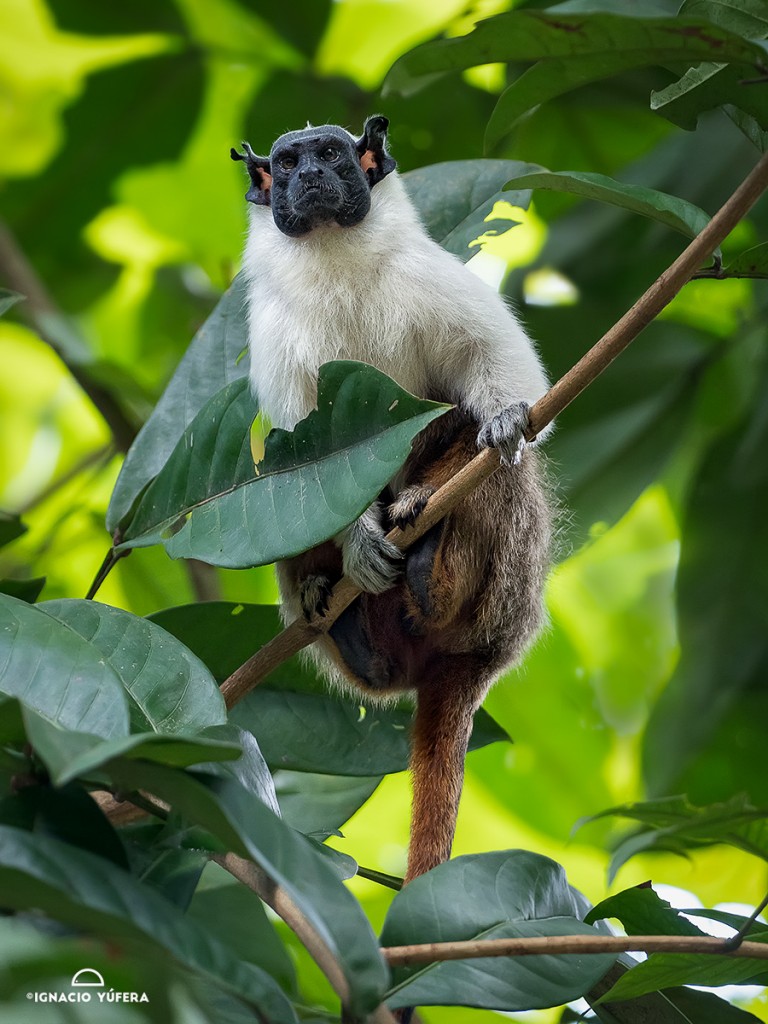
Pied Bare-faced Tamarin, Saguinus bicolor. Photo Ignacio Yufera.
Pied Bare-faced Tamarin, Gold-and-white Marmoset, Santarem Marmoset, Maues Marmoset, Satere Marmoset, Common Squirrel Monkey, Bare-eared Squirrel Monkey, Humboldt’s White-fronted Capuchin, Spix’s White-fronted Capuchin, Brown Tufted Capuchin, Large-headed Capuchin, Baptista Lake Titi, Ashy-grey Titi, Hoffmanns’ Titi, Gray’s Bald-faced Monk Saki, Golden-faced Saki, Black Uakari, Guianan Red Howler Monkey, Venezuelan Red Howler Monkey, Amazon Black Howler Monkey, Amazon River Dolphin (Boto) and Tucuxi.
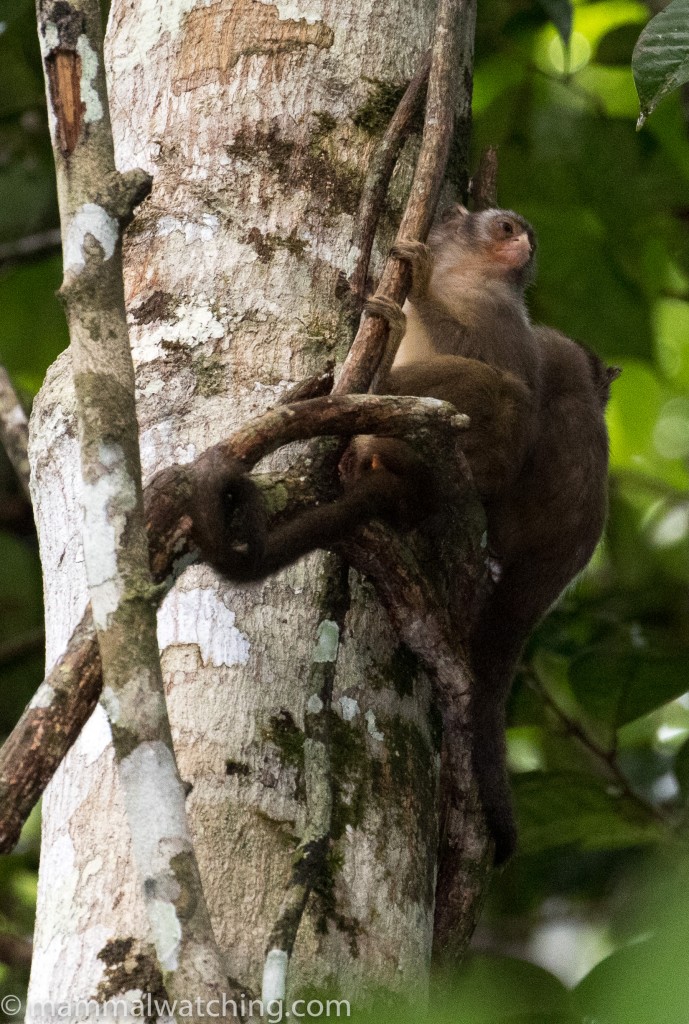
Black-crowned Dwarf Marmoset, Mico humilis
In October 2019 I returned for a 2 week cruise along the Rio Aripuana and Rio Madeira that picked up almost 60 species. There was considerable overlap with our 2017 trip though we added eight new ones to the list: the very localized Marca’s Marmoset and Prince Bernhard’s Titi Monkey and the barely known Black-crowned Dwarf Marmoset,
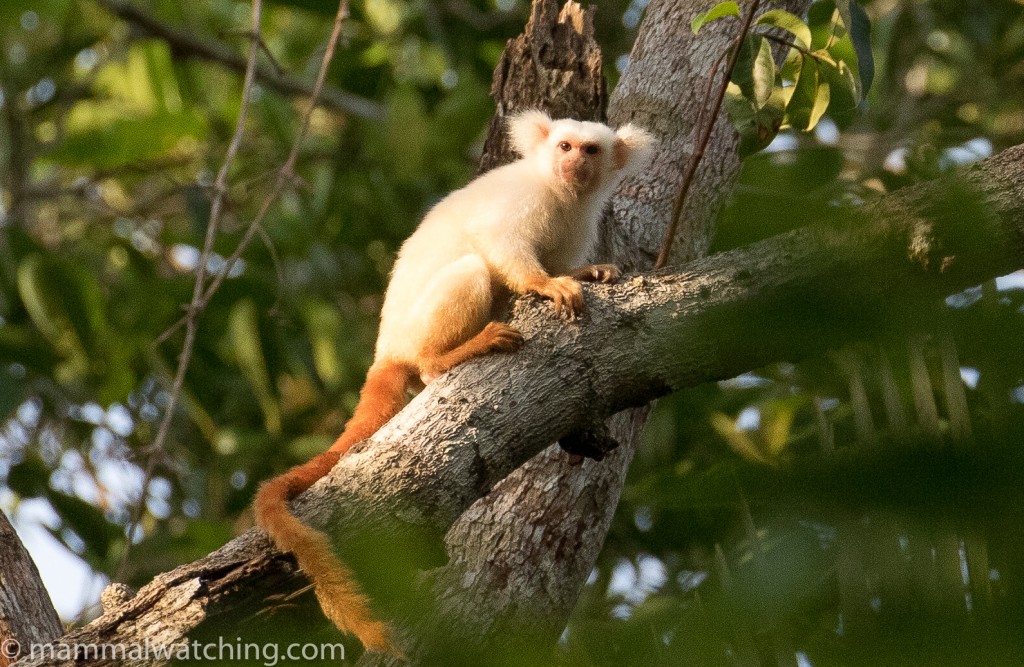
Gold and White Marmoset, Callithrix chrysoleuca
Other additional species in 2019 included Bare-tailed Woolly Opossum, Southern Stripe-heaeded Round-eared Bat, Baker’s Long-tongued Bat, White-winged Dog-like Bat, Short-headed Broad-nosed Bat, Bidentate Yellow-eared Bat and Cinnamon Dog-faced Bats.
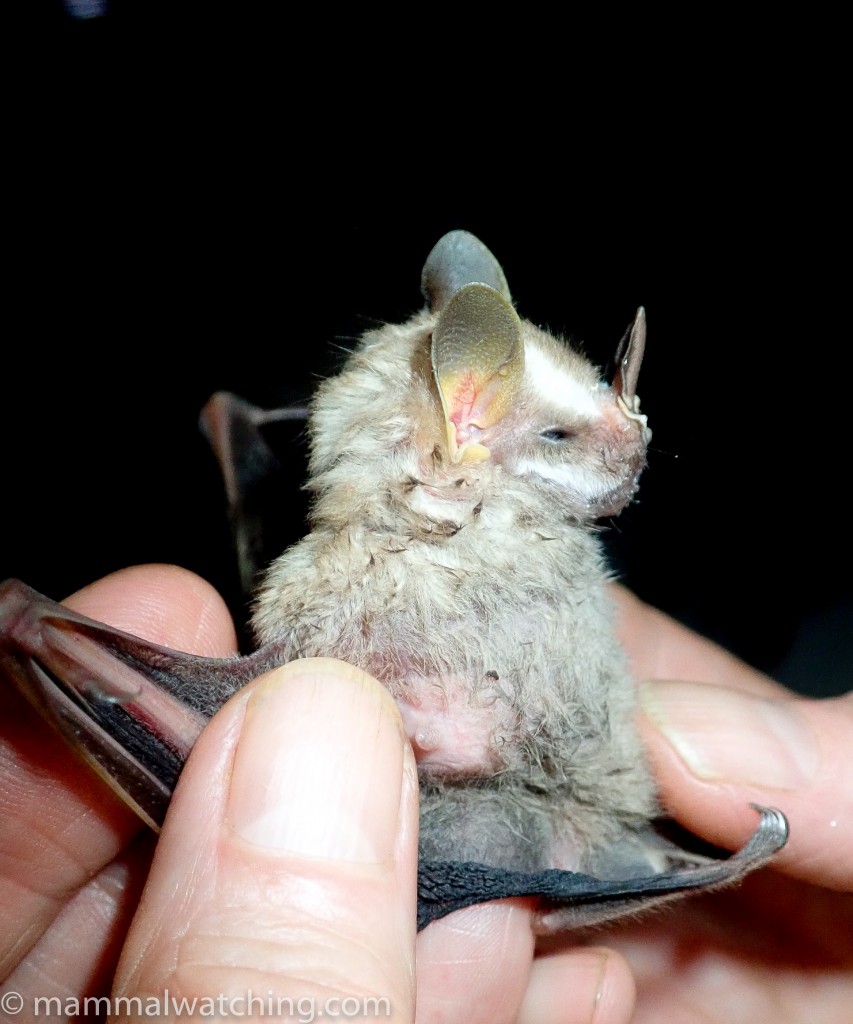
Short-headed Broad-nosed Bat, Platyrrhinus brachycephalus
Manaus
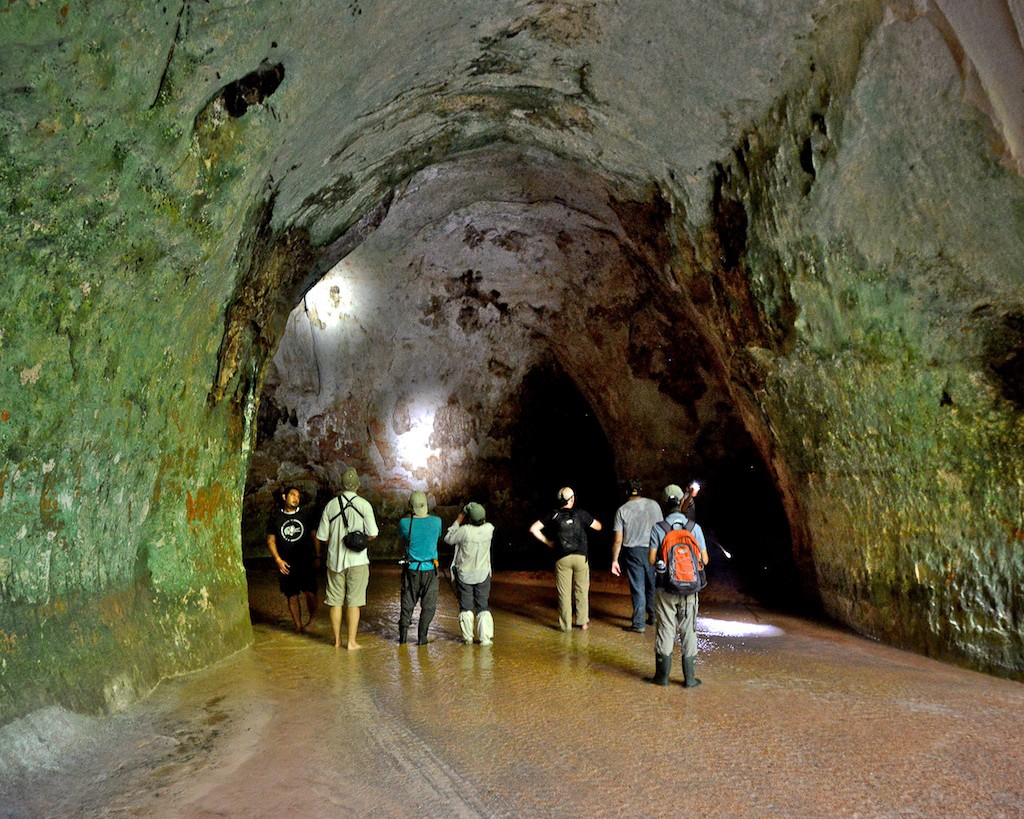
Presidente Figueiredo. Photo Charles Hood.
During a day trip to the Cock of the Rock caves at Presidente Figueiredo we saw Greater Spear-nosed Bats, Lesser Dog-like Bats, Common Vampire Bats, Rusty Moustached Bats and Silver-haired Myotis.
Novo Airão
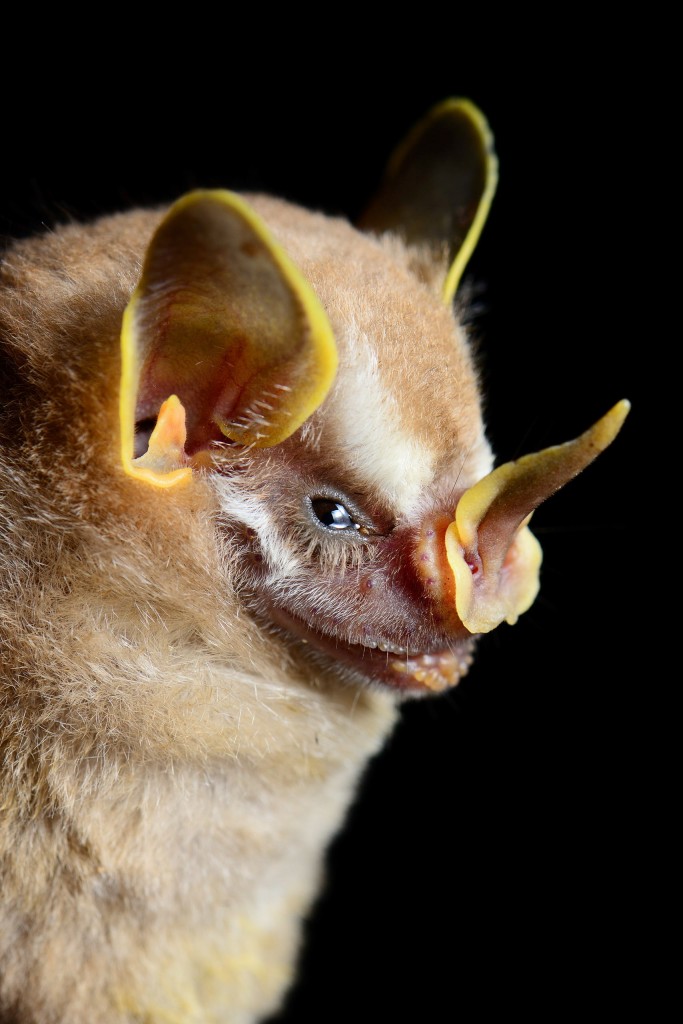
Dwarf Fruit Eating Bat, Dermanura gnomus. Photo Jose Gabriel Martinez.
Two nights here in 2017 were good for bats, with Frosted White-lined Bat, Chestnut Sac-winged Bat, Little Big-eared Bat, Seba’s Short-tailed Bat, Tilda Yellow-shouldered Bat, Great Fruit-eating Bat, Dark Fruit-eating Bat, Andersen’s Fruit-eating Bat, Dwarf Fruit Eating Bat, Brown Fruit-eating Bat, Argentine Brown Bat and Riparian Myotis.
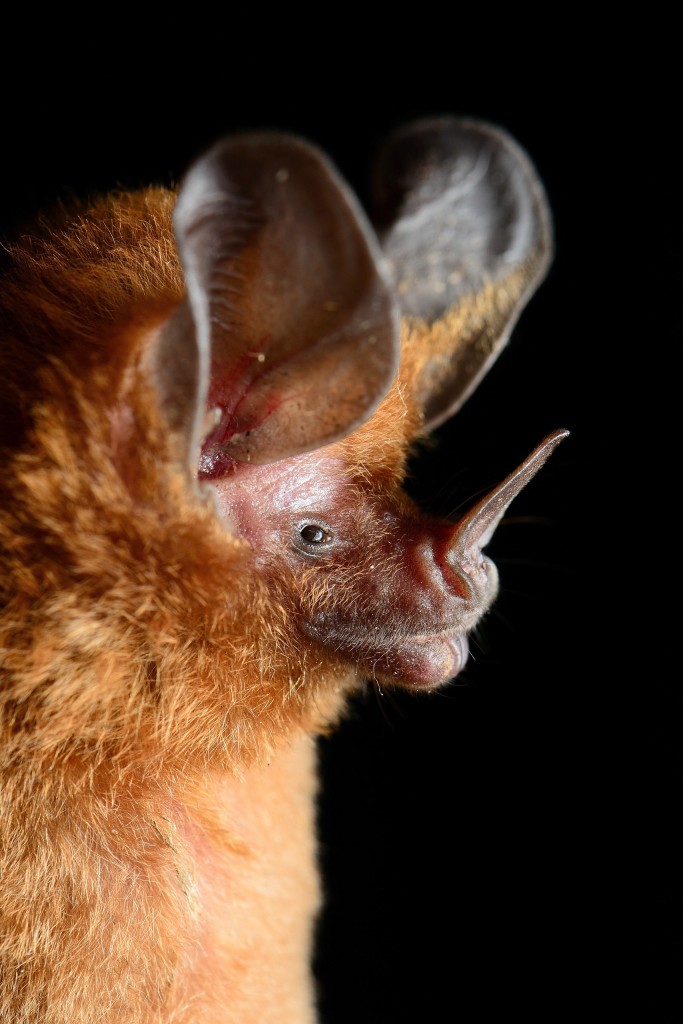
Little Big-eared Bat, Micronycteris megalotis. Photo Jose Gabriel Martinez.
We also saw a Bare-tailed Woolly Opossum, Brown-throated Three-toed Sloth and there were Noisy (Spix’s) Night Monkeys in the hotel gardens.
Rio Palmari
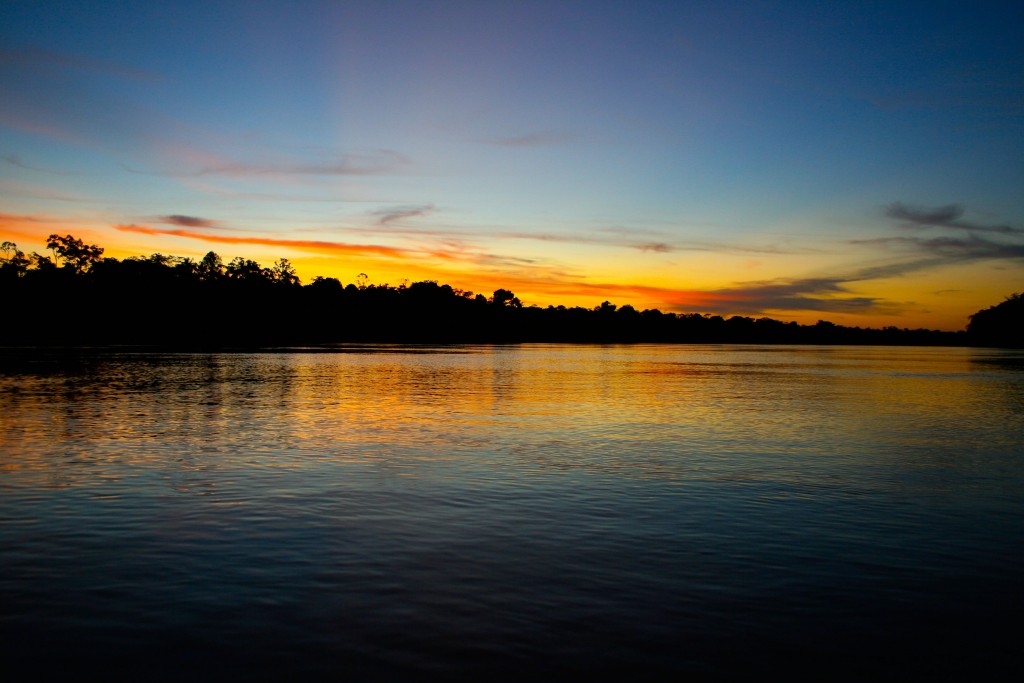
Rio Javari, Palmari
I spent five nights here in October 2006 and saw Boto, Tucuxi, Common Squirrel Monkey, Black-chested Moustached Tamarin, Saddleback Tamarin, Kinkajou, Black Agouti, Amazon Dwarf Squirrel, Nancy Ma’s Night Monkey, Amazonian Long-tailed Porcupine, Brown-Tufted Capuchin, Red Howler, Coppery Titi, Woolly Monkey, Monk Saki, Goeldi’s Monkey, Giant Otter, Collared Peccary, Short-Eared Dog. Palmari is a great spot. A more basic experience than some of the more luxurious lodges in the Amazon but an interesting set of species. There are not a many mammals close to the lodge and far the best way to see the more interesting animals is to take a overnight hike into the forest with one of the excellent guides (ideally for several nights).
Bahia
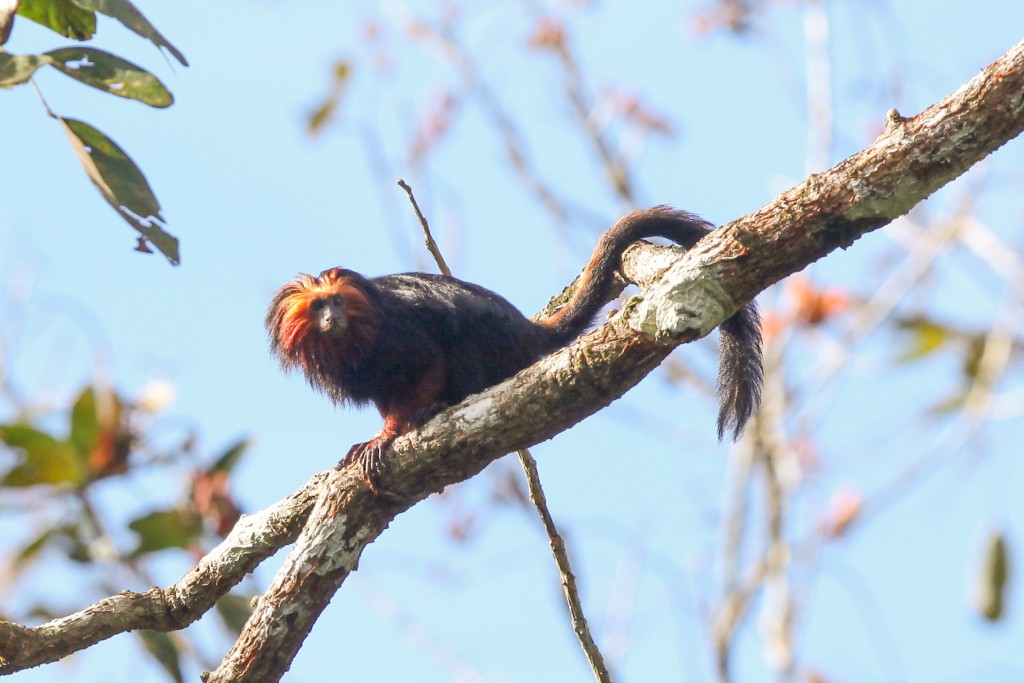
Golden-headed Lion Tamarin, Leontopithecus chrysomelas, Una Ecoparque
Serra Bonita
I was here for two nights in August 2013 and saw Yellow-breasted Capuchin, Weid’s Marmoset, Paca and Crab-eating Fox.
Una
I spent two nights here in August 2013 and found Golden-headed Lion Tamarin, Coastal Black-handed Titi, Weid’s Marmoset, Crab-eating Fox and Guiana Dolphin.
Espirito Santo
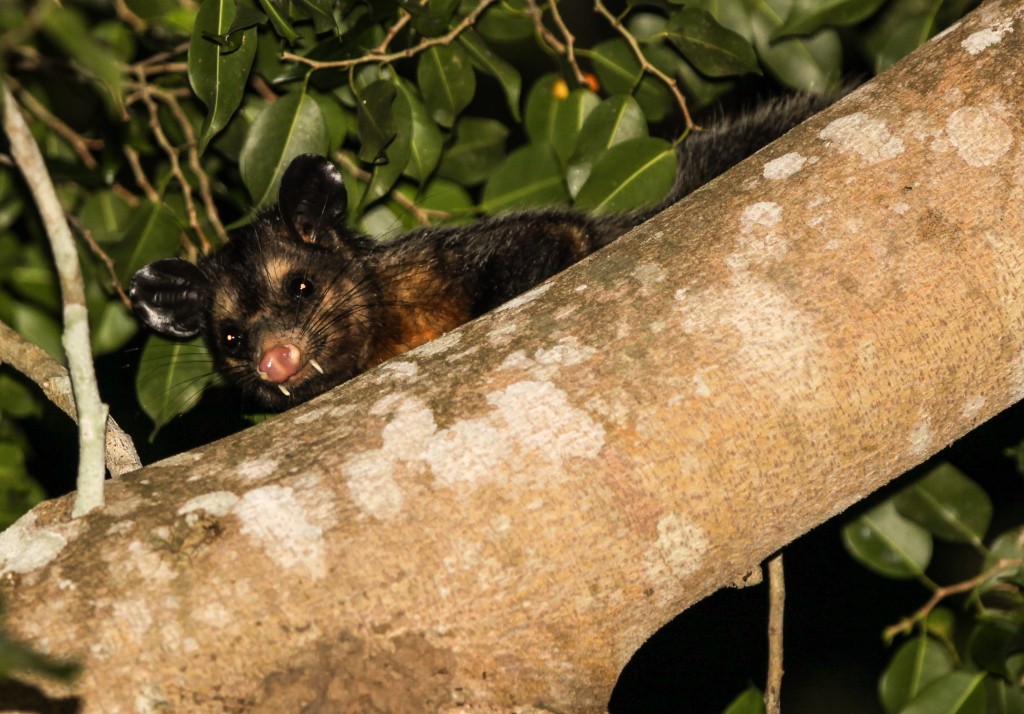
Southern Black-eared Opossum, Didelphis aurita, Linhares
Linhares Vale Biological Reserve
During a two night stay in August 2013 we saw Robust-tufted Capuchin, Geoffroy’s Marmoset, Common South-Eastern Opposum, Coatis, Fringe-lipped and Geoffroy’s Hairy-legged Bats and Masked Titis (heard).
Santa Maria Northern Muriqui Reserve
I spent less than a day here in August 2007 and saw Southern Maned Sloth, Northern Muriqui, Brown Howler, Guianan Squirrel, Buffy-headed Marmoset. A small patch of remnant forest that is well worth a visit. Maned Sloths are easy to see, while the research staff are very knowledgeable about the local fauna. It is possible to overnight here but unfortunately I didn’t know until I arrived.
Mato Grosso Do Sul
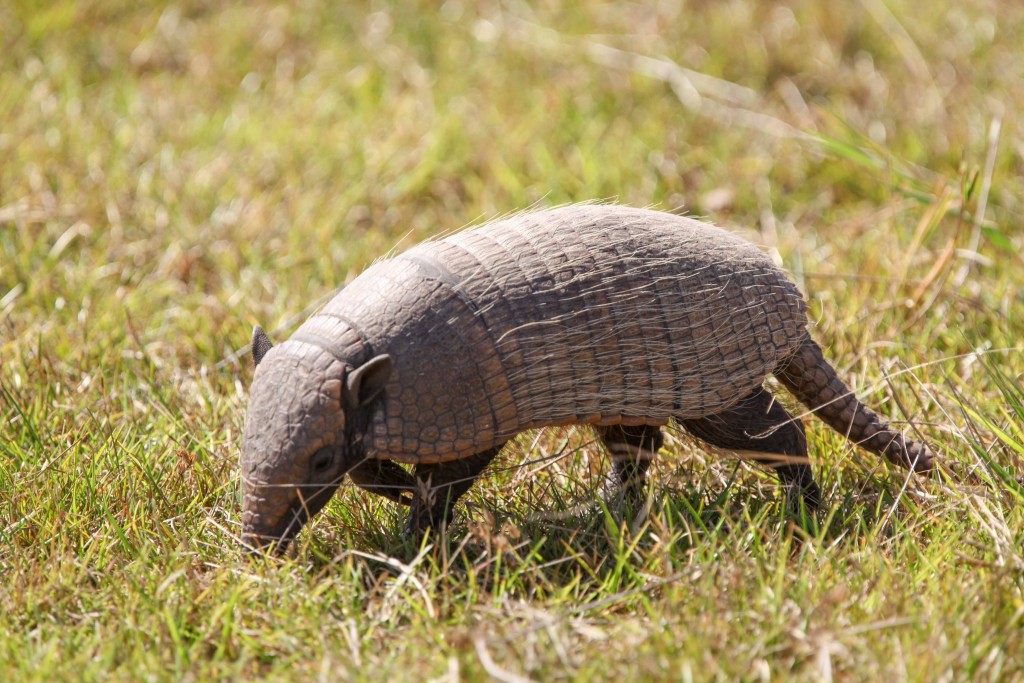
Six-banded Armadillo, Euphractus sexcintus, Baia das Pedras
Baia Das Pedras
Four nights here in August 2013 got me Giant Armadillo, Southern Naked-tailed Armadillo, Six-banded Armadillo, White-lipped Peccary, Feral Pig, Tapir, Coati, Marsh Deer, Pampas Deer, Red Brocket, Giant Anteater, Southern Tamandua, Crab-eating Fox, Crab-eating Raccoon, Puma (heard), Capybara, Common Punaré and Azara’s Agouti. A beautiful place and – because of the Giant Armadillo research – the best chance in the world to see the awesome Priodontes maximus! Tayra are also quite common here but I missed them.
Mato Grosso
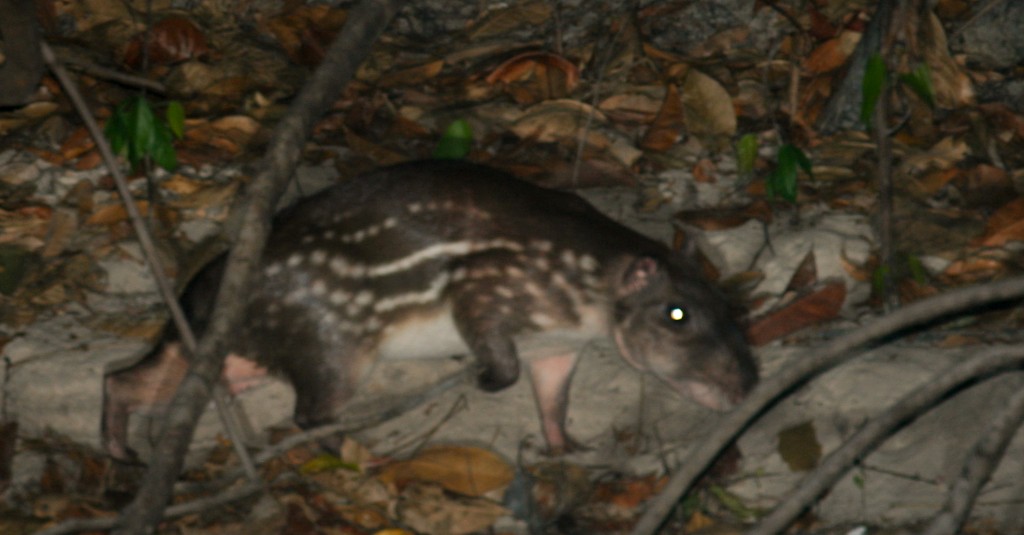
Paca, Cuniculus paca, Rio Cristalino
Rio Cristalino
A three night stay here in August 2007 produced Azara’s Night Monkey (the infulatus sub sp) , White-Whiskered Spider Monkey, White-Nosed Bearded Saki, Red-Handed Howler, Dusky Titi, Brown-Tufted Capuchin, Neotropical River Otter, Brazilian Tapir, Lesser White-lined Bat, Capybara, Paca, Grey Brocket Deer. A comfortable lodge, with some great guides and staff, in a pristine section of Amazonian forest. Wildlife seems largely undisturbed and probably at near natural levels of abundance. A great place to look for Tapirs and Pacas as well as some good primate species.
The Pantanal
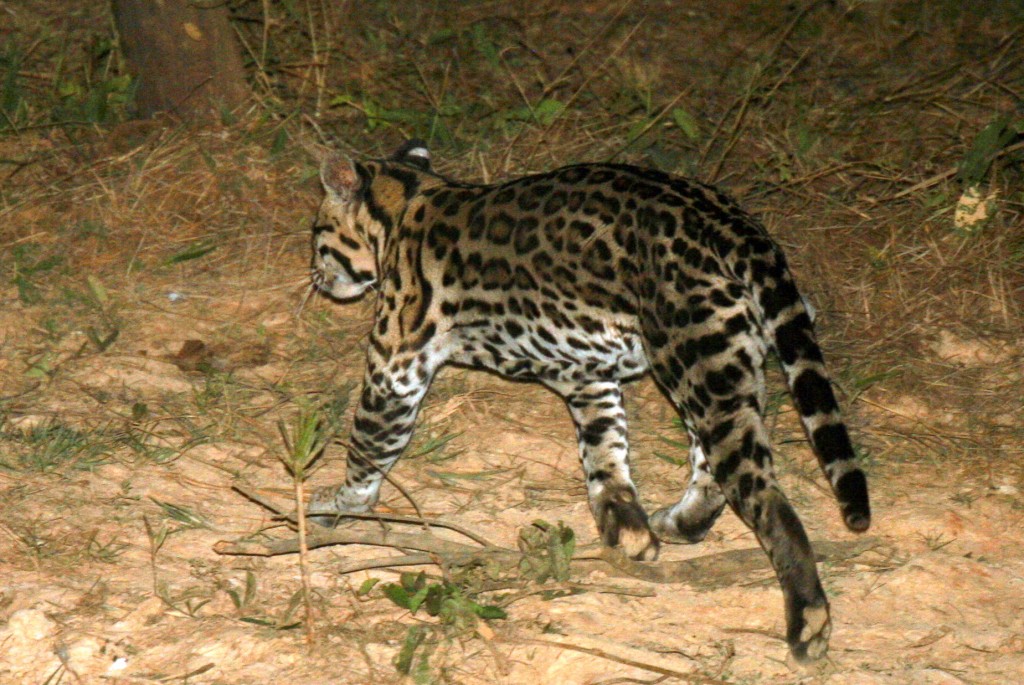
Ocelot, Felis pardalis, Transpantaneira
In August 2007 I spent a week driving the Transpantaneira Road from Cuiaba to Porto Jofre and saw a lot of mammals: Nine-banded Armadillo, South-eastern (Grey) Four-Eyed Opossum, Giant Anteater, Southern Tamandua, Brazilian Tapir, Crab-Eating Fox, Crab-Eating Raccoon, Giant Otter, Neotropical River Otter, Ocelot, Jaguar, Black-tailed (Pantanal) Marmoset, Black Howler, Hooded Capuchin, South American Coati, Azara’s Agouti, Forest Rabbit, Capybara, Marsh Deer, Red Brocket Deer, Grey Brocket Deer, Long-nosed Bat, Greater Fishing Bat, Lesser Fishing Bat, Pallas’s Mastiff Bat, Flat-faced Fruit-eating Bat, Inca Broad-nosed Bat. I can’t imagine wildlife watching in the neotropics gets much better than the Pantanal. There are many ecolodges along the 130km stretch of road than penetrates the Pantanal south of Cuiaba which vary in price and luxury. So far as I could tell there are more animals (both in abundance and diversity) along the first 40 kms. But the end of the road is an altogether better wilderness experience and it’s the best area for Jaguars and Tapirs. Pousada Jaguar about 90km down the road seems a particularly good spot for cats.
Minas Gerais
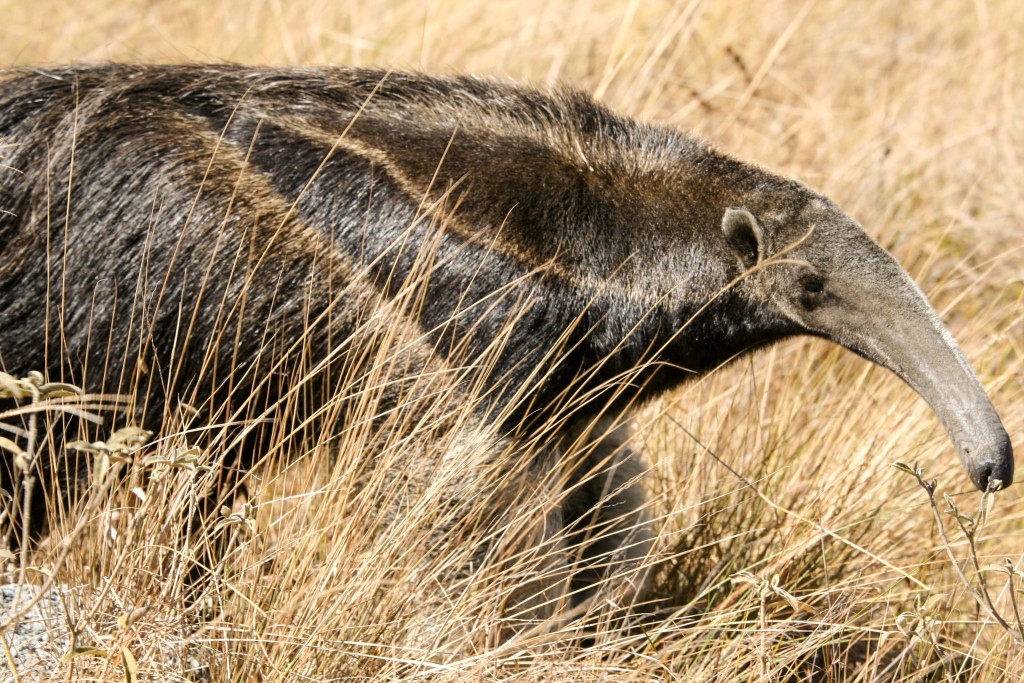
Giant Anteater, Myrmecophaga tridactyla, Canastra
Canastra National Park
I spent two nights here in August 2007 and saw Giant Anteater, Maned Wolf, Pampas Deer, Black-tufted Marmoset. A beautiful park with abundant Giant Anteaters and also a good chance of seeing a Maned Wolves.
Caraca
I also spent two nights here in August 2007 and we had Black-fronted Titi, Black-tufted Marmoset, Brazilian Guinea Pig, Guianan Squirrel, Black Myotis, Brazilian Free-tailed Bat, Maned Wolf. An interesting place. I’d avoid the weekends; it was packed on a Saturday night. But it’s a good place to see Black-fronted Titi Monkeys and a few other things. Plus you get to see Maned Wolves close up when they come to feed from the front patio every night.
Caratinga
Two nights here in August 2007 found South-Eastern Common Opossum, Brown Howler, Northern Black-horned Capuchin, Buffy-headed Marmoset, Northern Muriqui, Red-Rumped Agouti, Seba’s Short-tailed Fruit Bat. A small patch of rainforest that holds an excellent range of primates and where Muriquis are almost guaranteed. Definitely worth a visit.
Sitio Graciema
I stopped in here briefly in August 2007, to see Geoffrey’s Marmosets and Common Long-tongued Bats. I guess you’d need to speak to one of the locals, or a guide, to arrange access to this private small holding where a habituated troop of introduced Geoffroy’s Marmosets are easy to see. A detailed report is here.
Parana
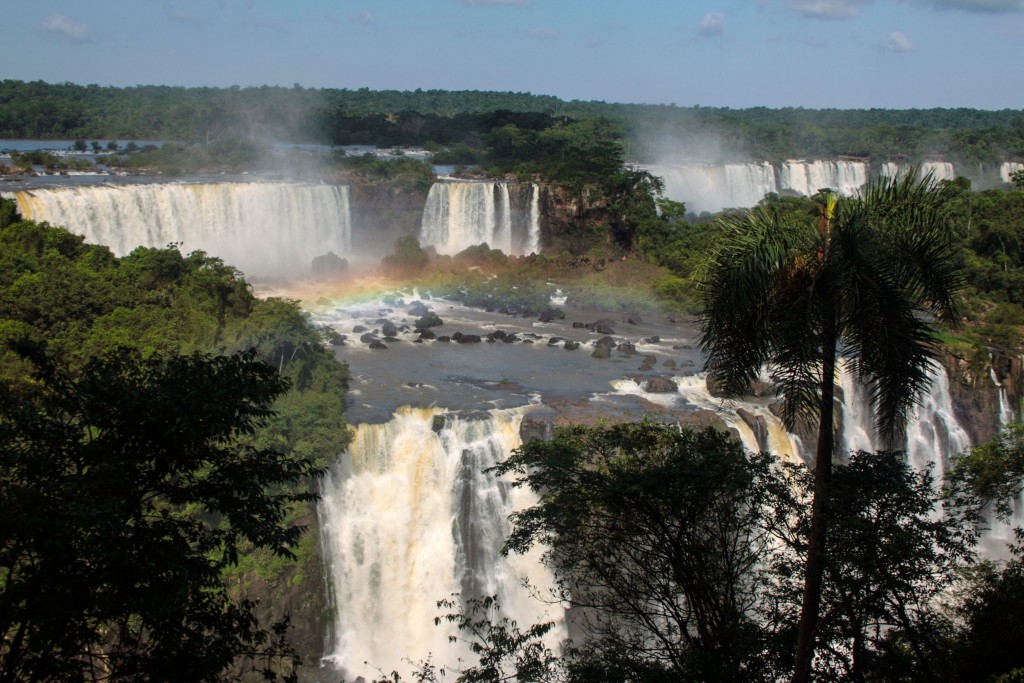
Iguasu/Iguazu Falls
Iguazu
I visited Iguazu Falls during a work trip in November 2009. The falls are spectacular enough and are set in a nice national park. But they draw a million visitors a year so they are crowded and heavily regulated. South American Coatis are common though I only saw a few on both the Brazilian and Argentinian sides. Brazilian Cavies are very common around the shops and restaurants at the Argentinian entrance and I also saw some Southern Black-horned Capuchins here (apparently these are less common). You are unable to enter the park at night unless you are staying at one of the two fancy hotels inside.
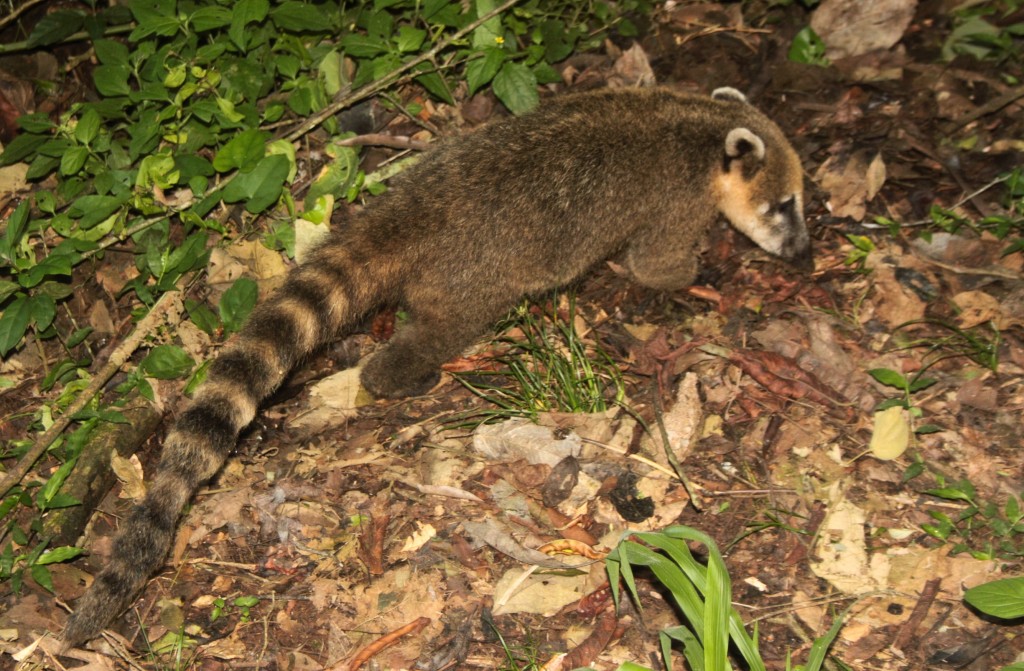
South American Coati, Nasua nasua
Apparently Red and sometimes Pygmy Brocket Deer (rare and restricted to the area where the Paraguay/Argentina/Brazil broders meet) are seen inside the park, usually when people are returning to the hotel from dinner in town. If you were staying in one of the hotels then, although in principle you aren’t supposed to walk at night along any trails, I suspect no one would be there to stop you, so that would be worth a shot. I used Alex Bassi as a local guide: he’s a good naturalist and a nice guy and knows the park well, though he didn’t have any specific spots to look for Pygmy Brocket Deer which I half hoped I might try for.
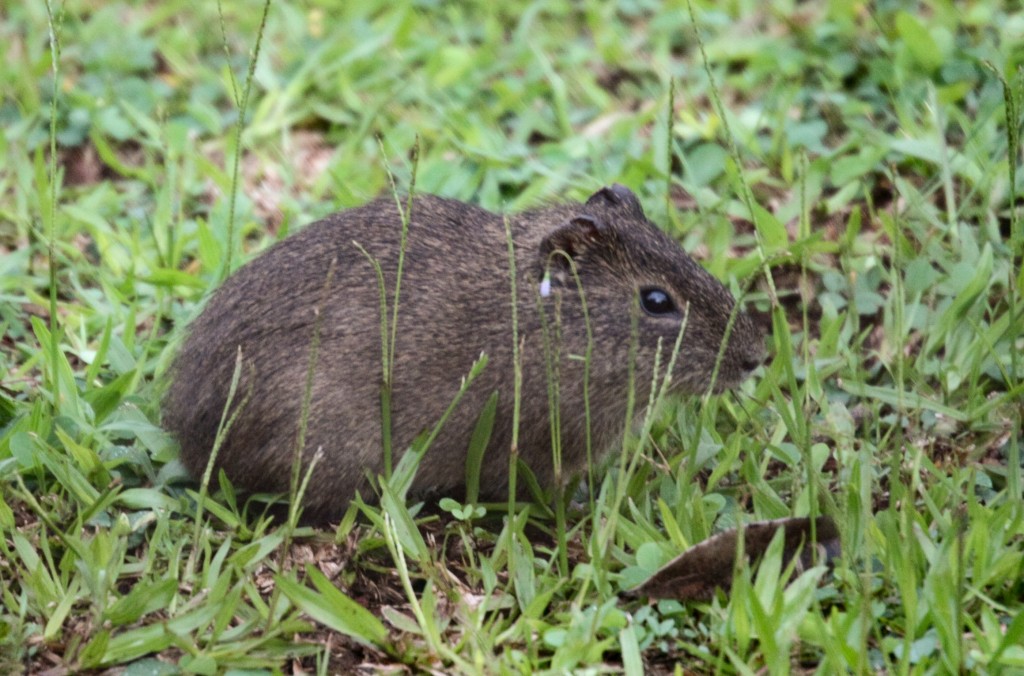
Brazilian Cavy, Cavia aperea
Superagui Island
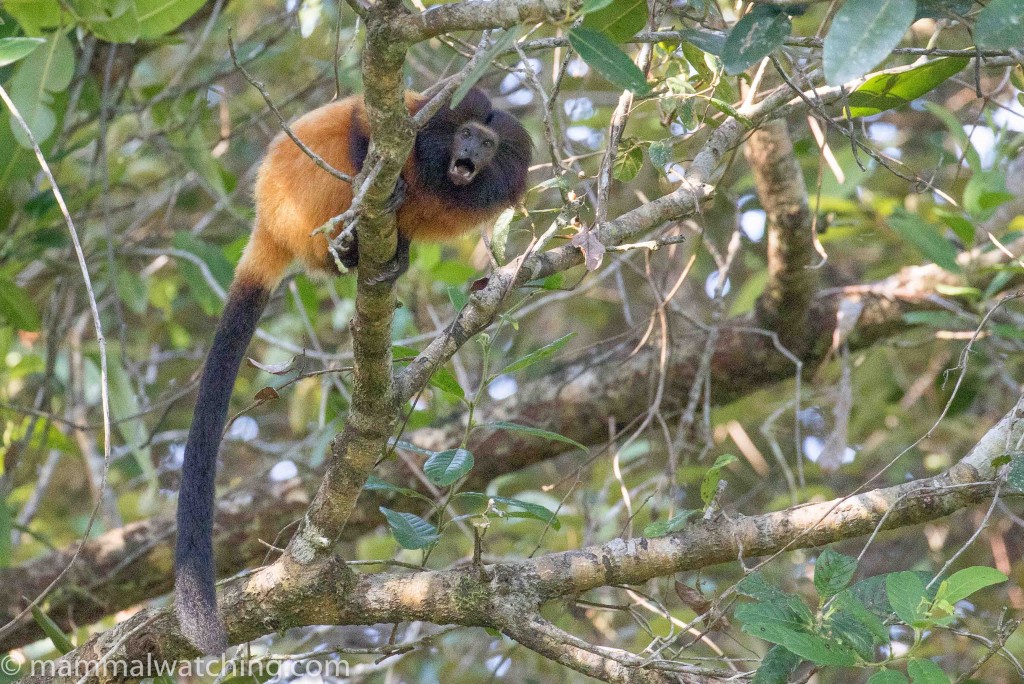
Black-faced Lion Tamarin, Leontopithecus caissara
Three nights on this island paradise in 2018 produced Black-faced Lion Tamarins, Guianan Dolphins and a White-eared Opossum.
Rio de Janeiro State
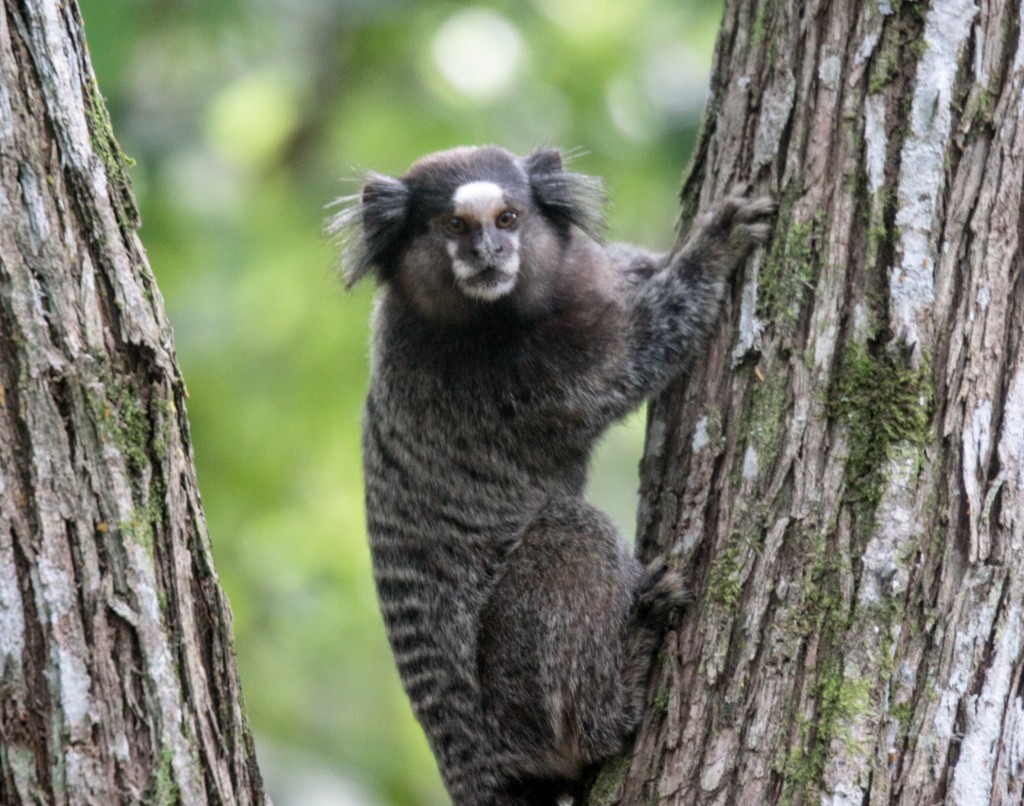
Hybrid Marmoset, Callithrix jacchus x penicillata
Rio De Janeiro
The Botanical Gardens and the Parque Nacional da Tijuaca in the middle of town are both good places to look for Northern Black-horned Capuchins and the feral Common Marmosets. Alcides Maia is a local guide who knows the area and its birds and mammals well and was very helpful. No hesitation in recommending him.
Poço das Antas Biological Reserve
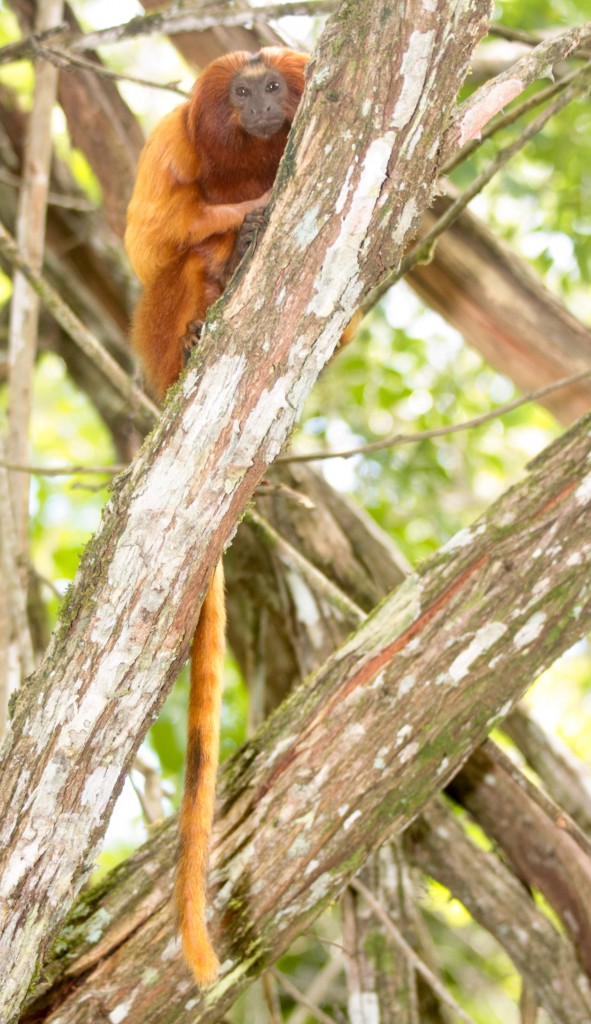
Golden Lion Tamarin, Leontopithecus rosalia
Poço das Antas Biological Reserve is a network of Atlantic Rainforest fragments that is home to a, so far, successful project to reintroduced Golden Lion Tamarins. The project works with local landowners to restore the forest and connect the fragments. In 1983 only 150 tamarins remained in the wild. The reintroduction and habitat restoration work has seen the population swell to 1500. You can visit the centre and arrange to see some tamarins, which are easy to find because a biologist will take you to one of the families currently radio collared. Porcupines – I think the Orange-spined Dwarf Hairy Porcupine – are also quite common around the project office I was told, though I couldn’t see one. They might be easier to see when the papayas are in fruit. Introduced Common and Black Pencilled Marmosets (and hybrids of the two) are usually hanging out with the tamarins.
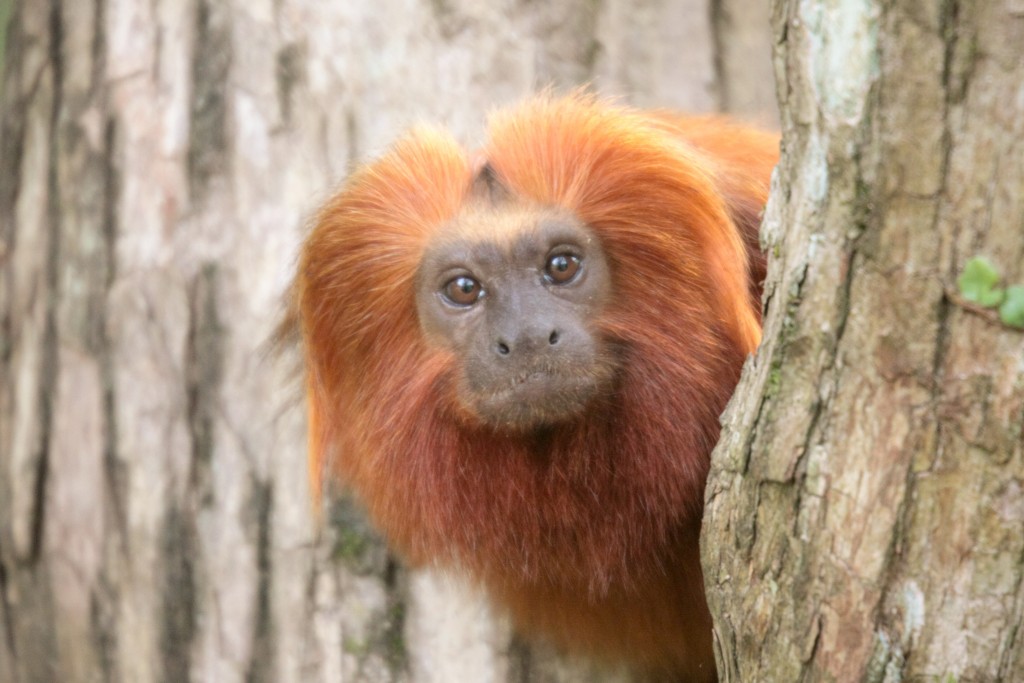
Golden Lion Tamarin, Leontopithecus rosalia
It can be done as a day trip from Rio but I stayed overnight in the basic but comfortable Fazenda Bom Retiro homestead which has its own tamarins (contact Luis Nelson, the owner there). Despite an evening followed by a night walk in the Bom Retiro rainforest I couldn’t find any mammals. But there are animals around including Tayras. if you are on a diet then don’t go there: the food was great and came in industrial quantities.
I arranged the visit – as I did my 2007 trip to Brazil – with the excellent Brazil Aventuras who organized it all at short notice and didn’t worry about my paying until I got back to France. Nice to see such trust still exists in Brazil. Contact Homero there. The tamarin project only takes one group a day (and one person can count as a group) so you need to book in advance. The costs of visiting includes a fairly substantial donation to the project. (Here’s a 2016 update on visiting the reserve). Information on visiting from 2018 is in this thread.
Sao Paolo State
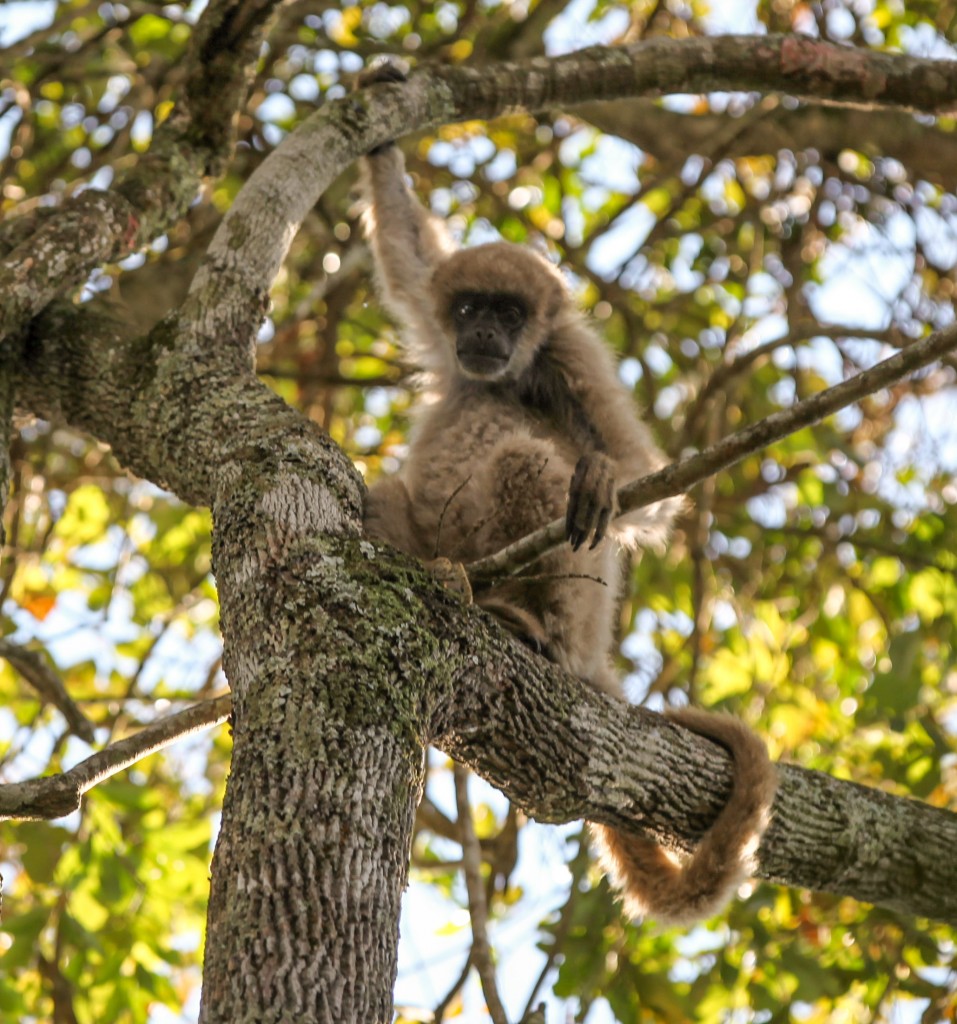
Southern Muriqui, Brachyteles arachnnoides, Fazenda Bacury
Fazenda Bacury
During two nights in August 2013 I saw Southern Muriqui, Southern Black-horned Capuchin, Brown Howler, Black-fronted Titi (heard), Jaguarundi, Tayra, White-eared Opposum. A great slab of Atlantic Rainforest which comes with fabulous accomodation, excellent food and the peace and freedom to look for stuff without anyone else to bother you.
Nazareth Paulista
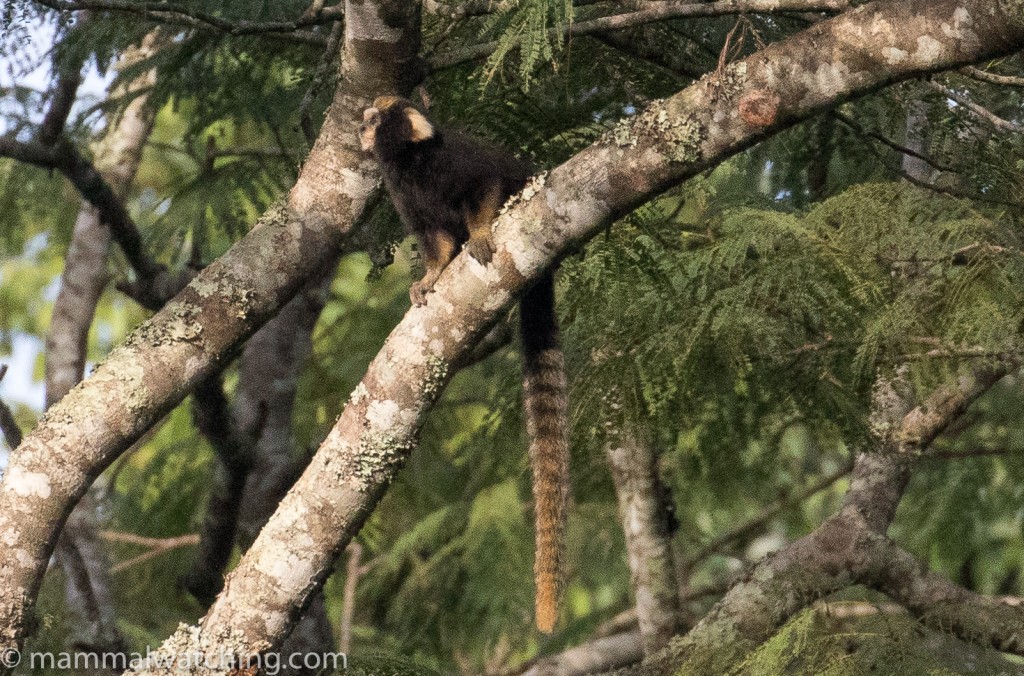
Buffy-tufted Marmoset, Callithrix aurita
I stopped here for a couple of hours in August 2013. I was late arriving here which is probably why I missed the Buffy-tufted Marmosets and Black-fronted Titis I had come to see. I did see a Guianan Squirrel. I saw the marmosets when I returned in early one morning in 2018.
Teodoro Sampaio
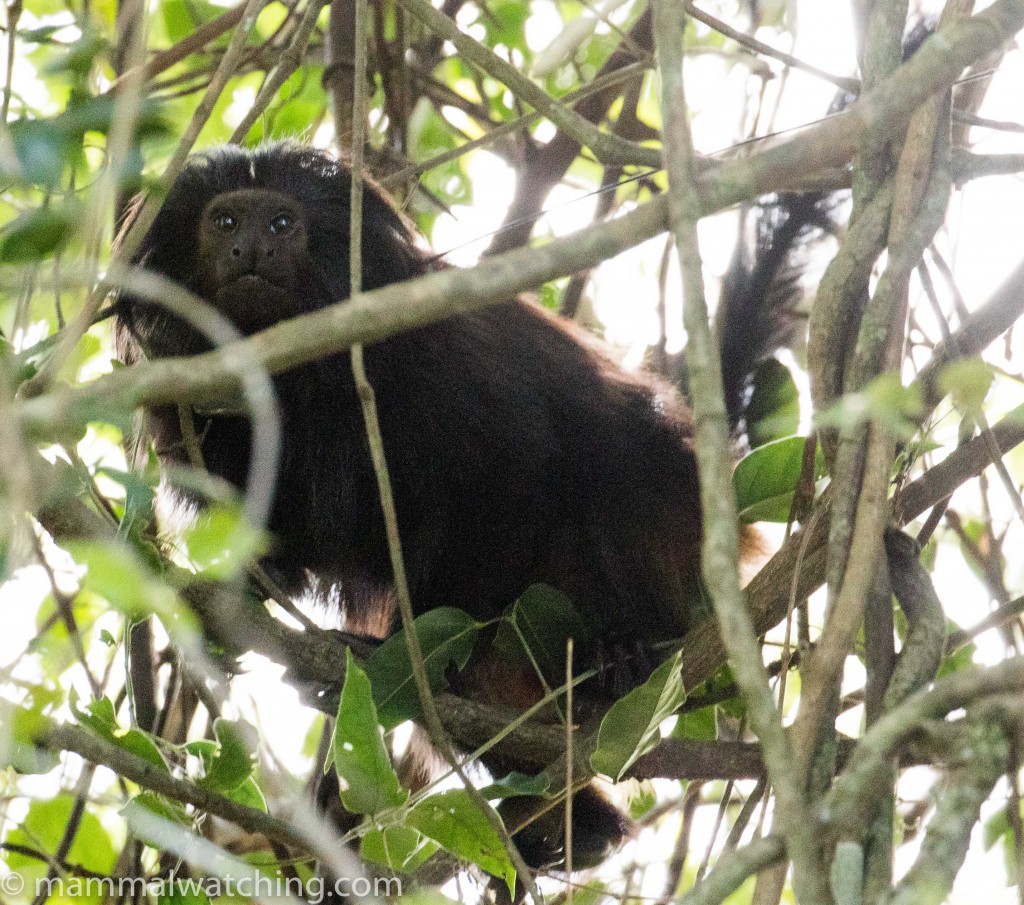
Black Lion Tamarin, Leontopithecus chrysopygus
In 2018 I spent a successful morning at Black Lion Tamarin project near Morro do Diabo National Park.
Community Reports
The World’s Best Mammalwatching
Brazil is an enormous, mega-diverse country. It needs many trips to do it justice. The Atlantic Rainforest and the northern Pantanal are just two areas that offer outstanding mammalwatching. But, for this list, I choose two other destinations. First, Arnaud Desbiez’s Giant Armadillo Project at Baia das Pedras ranch in the southern Pantanal is outstanding. This is a lovely farm, with a bunch of great mammals topped off with the jewel in the crown – Giant Armadillos, one of the very best beasts on the planet. And Arnaud is one of the nicest, most committed and hardest working scientists on the planet too. A true inspiration. See my 2013 report. Meanwhile every mammalwatcher wants to visit the Amazon and there is no better way than by cruising the river system, a trip which WildWings now offers regularly for example. Two weeks cruising the Amazon in 2017 produced 79 mammal species and 50 of those were new for me. Not bad after multiple trips to Central and South America. See more of the World’s Best Mammalwatching.
Mata Atlantica Brazil plus Laguna Ibera Argentina, 2024: Anna Bauerová, 6 weeks & 27 species including Geoffroy’s Cat and Golden Lion Tamarin.
WildWings Amazon Cruise, 2024: Alex Schouten and Jeannette den Hertog, 3 weeks & 36 species of primates including Martin’s Bare-faced Tamarin, Chestnut-bellied Titi, Black-faced Uacari and Eastern Black-handed Tamarin.
Northern Pantanal & Emas NP self-driving, 2024: Detlef Tibax, 2 weeks and 27 species including Hoary Fox, Maned Wolf and Jaguar. A very detailed report.
Piaui, Maranhao, Para and Mato Grosso, 2024: Cheryl Antonucci, 16 days & 37 species including Maranhao Red-Handed Howler Monkey, Eastern Black-handed Tamarin & Black-bearded Saki Monkey.
Eastern Brazil, 2024: Hugh Lansdown, 3 weeks & 13 species including Hoary Fox, Golden Lion Tamarin, Maned Wolf and Northern Muriqui.
Jaguars of the Pantanal, 2023: Cat Expeditions, 9 days & 19 species including Giant Anteater, Jaguar and Maned Wolf.
East Coast, 2023: Romain Boquier, 17 species including Hoary Fox, Maned Wolf and 11 primate species.
Emas and the Southern Pantanal, 2023: Wise Birding, 2 weeks & 28 species included Maned Wolf, Hoary Fox, Tayra and Lesser Grison.
The Pantanal and Trijunção, 2023: Brett Hartl, 2 weeks & many species including Maned Wolf, Spix’s Yellow-toothed Cavy, Jaguarundi and Giant Anteater.
Emas NP and the Pantanal, 2023: Coke Smith, 2 weeks & 37 species including Brown Brocket, Maned Wolf, Giant Anteater, Ocelot and Jaguar.
Manaus, 2023: Coke Smith, 5 days & 12 species including Golden-faced Saki and Pied Tamarin..
Atlantic Rainforest, 2023: Coke Smith, 3 weeks & 40 species iincluding Maned Wolf, Southern Naked-tailed Armadillo, both Maned Sloths and 20 species of primates.
Northern Pantanal & Emas, 2023: Jan Ebr, 18 days & 36+ species including Maned Wolf, Southern Naked-tailed Armadillo and Long-tailed Porcupine.
Amazon and Atlantic Rainforests, 2023: Cheryl Antonucci, 2.5 weeks & 38 species including Rondon Marmoset, Red-bellied Tamarin, Silvery Marmoset and Bahian Hairy Dwarf Porcupine.
Northern Pantanal, 2023: Bud Lensing, 5 days & species including Giant Anteater, Ocelot, Jaguar and Giant Otters.
SE Brazil, 2022: Alex Schouten and Jeannette den Hertog’s notes on where to see 8 primate species including Golden Lion Tamarin, Robust Capuchin, Buffy-headed Marmoset and Southern Muriqui.
Brazil, 2022: Jens Bokelaar, 29 days & 32 species including Southern Muriqui, Northern and Southern Maned Sloths, Crested and Yellow-breasted Capuchins and a Lesser Grison.
Southern and Northern Pantanal, 2022: John Wright & Tim Bourne, 2 weeks & 41 species including Chaco Marsh Rat, Pantanal Cat, Jaguarundi, Ocelot and Jaguar.
Peru and Brazil, 2022: Justin Brown, 4 weeks & many species with 25 different primates alone including Yellow-tailed Woolly Monkey, Red-backed Bearded Saki, Martin’s Ochraceous Bare-Face Tamarin and Schneider’s Marmoset.
Emas NP & the Pantanal (plus Bolivia), 2022: Guido Rommens & Micheline De Vleminck’s report of a trip to Bolivia and Brazil with Brazilian highlights including Hoary Foxes, Giant Anteaters and Jaguars.
Golden Lion Tamarins near Buzio, 2022: Shaun’s report on a site for Golden Lion Tamarins near a beach resort.
Emas NP & the Pantanal, 2022: Rob & Romy Jansen, 19 days & 33 species including Hoary Fox, Jaguar and Maned Wolf.
Central Cerrado & Atlantic Rainforest, 2022: Rob & Romy Jansen, 10 weeks & 34 species including Golden and Black Lion Tamarins, Maned Wolf and Giant Anteater.
Alta Floresta and Rio Grande Do Sul, 2022: Andreas Jonsson, 2 weeks & 28 species including Southern Tigrina, Geoffroy’s Cat, Red-handed Howler Monkey, Groves’s Titi Monkey and Emilia’s Marmoset.
Eastern Brazil, 2021: Cheryl Antonucci, 19 days & 34 species including Black and Golden-headed Lion Tamarins, Yellow-breasted and Blond Capuchins and Uta Hick’s Bearded Sakis.
Brazil, 2021: Alex Meyer, 23 days and 59 species including Superagui Lion Tamarin, Lami Tuco-tuco, Coastal Black-handed Titi, Bahia Porcupine and many of the more usual suspects.
Rio Aripuana and Rio Madeira Cruise, 2019: Jon Hall, 2 weeks & 59 species including Black-crowned Dwarf Marmoset, Marca Marmoset and White-winged Dog-like Bat. And here is Stefan Lithner’s report from the same trip.
Brazil, 2019: Ben Balmford, 4 weeks & 57 species including Ocelot, White and Black Uakaris, Pampas Cat and much more.
Paraguayan Chaco and Emas National Park, Brazil, 2019: Dominique Brugiere, 2 weeks & species including Ocelot, Jaguar, Chacoan Peccary in Paraguay and a Maned Wolf in Brazil.
Northern Pantanal and Emas NP, 2019: Sophie and Manuel Baumgartner, 1 month & 40 species including Brown Four-eyed Opossum, Hoary Fox, Pampas Cat, Ocelot and Southern Oncilla
Atlantic Rainforest, 2019: Justin Brown, 3 weeks & sites I wasn’t aware of for some nice primates including Black Lion Tamarin, and Yellow-breasted and Blond Capuchins
Emas National Park, 2019: Andreas Jonsson, 5 nights and 11 species including Pampas Cats, Hoary Fox and Striped Hognosed Skunk.
Amazon Cruise, 2019: Chris Collins (WildWings), 2 weeks & 40+ species including 26 primates on the main tour such as Silvery Marmoset, Red-bellied Titi, Red-nosed Bearded Saki and Martin’s Bare-faced Tamarin.
Amazon Adventure, 2019: Fiona Reid’s report of 2 weeks on the Rios Solimoes and Negro, with 49 species including Red-backed Beaarded Saki, Red-rumped Agouti and Delicate Slender Mouse Opossum.
Fazenda Bacury, 2019: Roland Wirth’s brief note of a visit to see the Southern Muriquis. Also featuring a Jaguarundi.
The Pantanal, 2019: Naturetrek, 10 days & 23 species including Jaguar, Tayra and Giant Otter.
Big Cats in Torres del Paine and the Pantanal, 2019: Naturetrek, 16 days & 27 species including Jaguar, Puma and Andean Deer.
Giant Armadillo and Kabomani Tapirs, 2018: Royle Safaris, 12 days & 40 species including Common Water Rat and Giant Armadillo, with some interesting references to the disputed “Kabomani Tapir”.
Amazon Cruise, September 2018: WildWings and Regina Ribeiro, 2 weeeks & 30+ species including Giant Otter, many rare primates and a Silky Anteater.
Pantanal, July 2018: Karl-Olof Bergman, 2 weeks & 20 species including Jaguar and Ocelot.
Brazil, 2018: Jo Dale, 3.5 weeks & 33 species including Giant Armadillo, Maned Wolf and multiple Jaguars and Ocelots.
Northeast Brazil, 2018: Michael Kessler, 10 days & 43 species including Northern Ghost Bat, Pernambuco Dwarf Porcupine, Baturite Porcupine and Yellow-breasted Capuchin.
Pantanal, 2018: Naturetrek, 12 days & 22 species including Jaguar and Ocelot.
Fazenda Bacury, Rio and the Southern Pantanal: Alan Dahl, 2 weeks & 28 species including Hoary Fox, Golden Lion Tamarins and Giant Anteaters.
Amazon Cruise, May 2018: Wildwings, 18 days & 50+ species, with 28 primates including Spix’s Black-heard Uacari, Lake Baptista Titi and Santarem Marmoset.
Pantanal, 2018: Stuart Chapman, 1 week & 20 species including Jaguar and Ocelot. PLEASE NOTE see Ben Balmford’s report about problems with the same guide that Stuart used.
Sao Paulo and Parana, 2018: Jon Hall, 10 days & 6 species including Buffy-tufted Marmosets, Black and Black-faced Lion Tamarins.
Amazon Expedition, 2017: Jon Hall & Fiona Reid, 2 weeks & 79 species including Black Uakari, Santarem, Satare, Maues and Gold and White and Marmosets, Pallid-winged Dog-like Bat and Black-tailed Hairy Dwarf Porcupine. Mega trip.
Manaus, 2017: Jon Hall, 3 days after the Amazon Cruise, with 22 species including Bare-tailed Woolly Opossum, Little Big-eared Bat and Dwarf Fruit-eating Bat.
Brazil, 2017: Alain Guillemont, 2 weeks with mammals including Southern Muriqui, Hoary Fox, Pampas Cat and Red-nosed Bearded Saki.
Brazil, 2017: Pieter de Groot Boersma’s video montage of 5 weeks in Brazil with species including Maned Wolf, Red-nosed Bearded Saki and Hoary Fox.
Pantanal, 2017: Royle Safaris, 18 days & 39 species including Tayra, Ocelot and Jaguar.
Manaus, 2017: Venkat Sankar, 2 days & 13 species including Golden-faced Saki, Tayra and Southern Tamandua.
Mamiraua, 2017: Ian Thompson, 4 days & 12 species including Red Uakari and Black-faced Squirrel Monkey.
Emas NP & Black Lion Tamarins, 2017: Richard Webb, 12 days & 21 species including Puma, Hoary Fox, Striped Hog-nosed Skunk, Tayra, Maned Wolf and Black Lion Tamarins.
The Pantanal (Brazil) and Torres del Paine (Chile): NozoMojo Tours, 8 days (in Brazil) & 17 species including Jaguars, Giant Anteater and a Yellow Armadillo.
Pantanal, 2016: Alan Dahl, 2 weeks & 22 species including Giant Anteater, Tayra and Jaguars.
Pantanal, November 2016: Karl-Olof Bergman, 12 days & 18 species including Jaguar, Margay and Ocelot.
Brazil, 2016: Samuel Marlin, 16 days & 22 species including 8 Jaguars and Maned Wolves.
Amazon, 2016: Fiona Reid, 2 week epic river trip with at least 45 species including 16 primates (including White-faced Saki, Grey’s Bald-faced Saki, Gold and White Marmoset and Pied Tamarin), great bats (Northern Ghost Bat and White-winged Vampire Bat), and nice rodents, like Amazon Bamboo Rat and Giant Tree Rat.
Pantanal, 2015-16: Mogens Trolle, 6 weeks & 23 species including Maned Wolf, Giant Anteater, Ocelot, Puma & Jaguar.
Northern Pantanal, 2015: Chris Townend, 11 days & 26 species including Tayra, Maned Wolf, Jaguar, Puma and an Ocelot.
Brazil (Central Amazonia), 2015: Fiona Reid, 2 weeks & 27 species including many primates, such as Hoffman’s Titi, Ashey Titi and Satere Marmoset and some nice rodents too.
Brazil, 2015: Steve Firth, 8 days & 18 species including Pantanal Cat, Brazilian Porcupine and Jaguar.
Brazil & Argentina, 2015: Phil Telfer, 18 days and some great species including, in Brazil, Pampas Cat, Jaguarundi, Lesser Grison and Ocelot.
Brazil, 2014: Paul Klockenbrink, 2 weeks & 17 species including Golden Lion Tamarin, Jaguar and Maned Wolf.
Emas, 2014: Richard Webb, 8 days & 19 species including a Giant Armadillo, Maned Wolf and Hoary Foxes.
Brazil: Atlantic Rainforest and the Pantanal, 2013: Jon Hall, 2 weeks & 41 species including Golden-headed Lion Tamarin, Yellow-breasted Capuchin, Fringe-lipped Bat and 2 Giant Armdadillos.
Pantanal & Emas, 2013: Wildwings, 11 days & 38 species including (several) Pampas Cats, Jaguar, Puma, Jaguarundi, Maned Wolf and Brazilian Porcupine.
Pantanal, 2013: John Pilgrim, 4 days & 20 species including Ocelot, Jaguar, Giant Anteater and Grey Four-eyed Opossum.
Brazil, 2013: Ian Loyd’s report of a 3.5 month stay in Brazil, mainly at the REGUA reserve in Rio State, but also some time in Minas Gerais, Amazonas and the Pantanal. He saw 55 species including Lesser Grison, Bare-tailed Woolly Opossum, Water Rat, Bamboo Rat and a Bald-headed Uacari.
Brazil, 2013: Michel Watelet, 3 weeks & 29 species including Jaguar, Tapir and a Yellow Armadillo.
Pantanal, September – October, 2013: Royle Safaris, 16 days & 30 species including Maned Wolf, Yellow Armadillo and many Jaguars.
Pantanal, September, 2013: Royle Safaris, 16 days & 34 species including Brazilian Porcupine, Tayra, Ocelot and many Jaguars.
Brazil, 2013: Igor Sarkassian, and an account of an Amazon boat trip and the Southern Pantanal. Species include Jaguar and Giant Armadillo.
Atlantic Rainforest, 2013: Steve Morgan’s detailed notes of a 2 month mammal survey in the REGUA reserve. He recorded 29 species including Orange-Spined Hairy Dwarf Porcupine, Tayra and Puma.
Brazil, 2012: Stefan Lithner, 12 days & 26 species including White-lipped Peccary, 6 and 7 Banded Armadillos, and Jaguar.
Brazil, 2012: Phil Telfer, 2 weeks with 30 or more species, the highlight though most undoubtedly a Giant Armadillo, as well as a Margay, Yellow and Southern Naked-tailed Armadillos, White-lipped Peccaries, Jaguar and more.
Pantanal, 2012: Royle Safaris, 16 days & 28 species including Big-eared Woolly Bat, Yellow Armadillo, Ocelot, Oncilla and many Jaguars.
Brazil, Paraguay and Peru, 2012: Romain Bocquier, mega-trip of 7 weeks & 43 species incuding Sechuran Fox & Taruca (Peru), Jaguar & Tayra (Brazil) and Jaguarundi & Geoffroy’s Cat (Paraguay).
Brazil, 2011: Janco Van Gelderen, 6 weeks & 31 species including Saki Monkey, Bamboo Rat, White-lipped Peccaries plus Jaguar, Maned Wolf, Tapir. Great report.
Brazil, 2011: Stefan Lithner, 6 weeks including a month at the REGUA reserve in the Atlantic rainforest & 40+ mammals including some interesting rodents – Southern Bamboo Rat and Orange-spined Hairy Dwarf Porcupine, Oncilla and Jaguarundi.
The Pantanal, 2011: Carmen and Torbjörn Lundqvist, 12 days & many species including Jaguars and a Six-banded Armadillo, plus some great photos.
Brazil, 2011: Indri Tours, 2 weeks & 27 species including Six-banded Armadilloes, White-lipped Peccaries and Jaguars.
Pantanal, 2011: Royle Safaris, 15 days & 23 species including two Hoary Foxes and many Jaguars.
Brazil, 2010: Ian Loyd, 2 weeks & 21 species including 4 Jaguars.
Brazil, 2010: Steve Davis, 2.5 weeks & 26 species including some great primates like Golden-headed Lion Tamarin, Wied’s Black-tufted Marmoset and 3 opossum species.
Brazil, 2010: Don Roberson, 3 weeks & 23 species including Jaguars, Maned Wolves and Yellow Armadillo. Great photos.
South East Brazil, 2010: Sjef Ollers, 3 weeks & 23+ species including several interesting prmates, Greater Grisons and an Orange Spined Hairy-dwarf Porcupine.
Brazilian Amazon, 2010: Bradley Davis, some notes on a couple of lodges with nice primates including Prince Bernhard’s Titi Monkey and Marca’s Marmoset.
Brazil, 2009: Tomer Ben-Yehuda, 10 days & 22 mammals.
Brazil, 2008: Richard Webb, 2 weeks & 35 mammals.
Brazil, 2008: Steve Anyon-Smith, 5 weeks & 43 mammals including Jaguars and a Kinkajou.
Brazil: Rio Cristalino, the Pantanal & the South East, 2007: Jon Hall, 2.5 weeks & 54 species including Jaguar, Northern Muriqui and White-whiskered Spider Monkey.
Brazil, Rio Palmari, 2006: Jon Hall, 4 days & 19 species including both River Dolphins, Brazilian Porcupine, Goeldi’s Monkey and a Short-eared Dog.
Brazil, 2006: Sjef Ollers, 2.5 weeks & 32 species including a Giant Armadillo in Emas National Park.
Brazil, 2006 – trip 2: Richard Webb, 2 weeks & 41 mammals.
Brazil, 2005 – trip 2: Richard Webb, 2 weeks & 32 mammals.
Brazil, 2005 – trip 1: Richard Webb, 2 weeks & 35 mammals.
Brazil, 2004 – trip 3: Richard Webb, 2 weeks & 34 mammals.
Brazil, 2004 – trip 2: Richard Webb, 1 month & 43 mammals.
Brazil, 2004 – trip 1 : Richard Webb, 1 week & 12 mammals.
Brazil, 2003: Richard Webb, 2 weeks & 27 mammals.
Brazil, 2001: Richard Webb, 2 weeks & 19 mammals.
Also See
Listen to Regina Ribeiro talking about guiding in Brazil on the mammalwatching podcast, February 2022
Listen to Arnaud Desbiez talk about his work with Giant Armadillos on the mammalwatching podcast, April 2023
Listen to Patricia Medici talk about her work on Tapirs on the mammalwatching podcast, December 2023
Listen to Fernando Tortato talking about is work with Jaguar tourism on the mammalwatching podcast, October 2024
RFI Recife, September 2024
Which Titi Monkeys are in Caraca?, May 2024
Margay in Sierra Bonita, May 2024
Bristle-spined Porcupines and Northern Maned Sloths in Aruá Forest, Bahia, April 2024
Giant Anteater ‘anti-predator mimicry‘, December 2023
Santuario do Caraca, October 2022
Mammal and bird watching near Sao Paulo, July 2022
Tapir at Caraca, March 2022
Goeldi’s Monkey in Chandless State Park, Acre (September, 2020)
RFI: Pantanal mammalwatching (not hard core) (July 2018)
Visiting the Golden Lion Tamarins in Rio de Janeiro State (2016 – 2018)
Vanzolini Saki Rediscovered (Aug 2017)
Visiting the Golden Lion Tamarins (Jan, 2016)
Fascinating article about Short-eared Dogs (July, 2014)
Mating Jaguars in the Pantanal (February, 2011).
Sightings from Amazonian Brazil – Primates and Short-eared Dog (March, 2010).
Resources
López-Baucells, Adrià et al. A Field Guide to Bats of the Amazon, 2018. Pelagic Publishing. This 170 page paperback is a remarkably easy to use illustrated guide to identifying all 160 species in the Amazon.
Pearson, D. and Beletsky, L. 2010. Travellers’ Wildlife Guides: Brazil (Amazon & Pantanal). Arris Publishing, UK. A general guide to the fauna of Brazil with some quite limited information on mammals and where to look for them.
Leave a Reply
You must be logged in to post a comment.



Shannon
Does anyone know if the Giant Armadillo Project is still running? I am looking to head to Brazil in July and would love to visit.